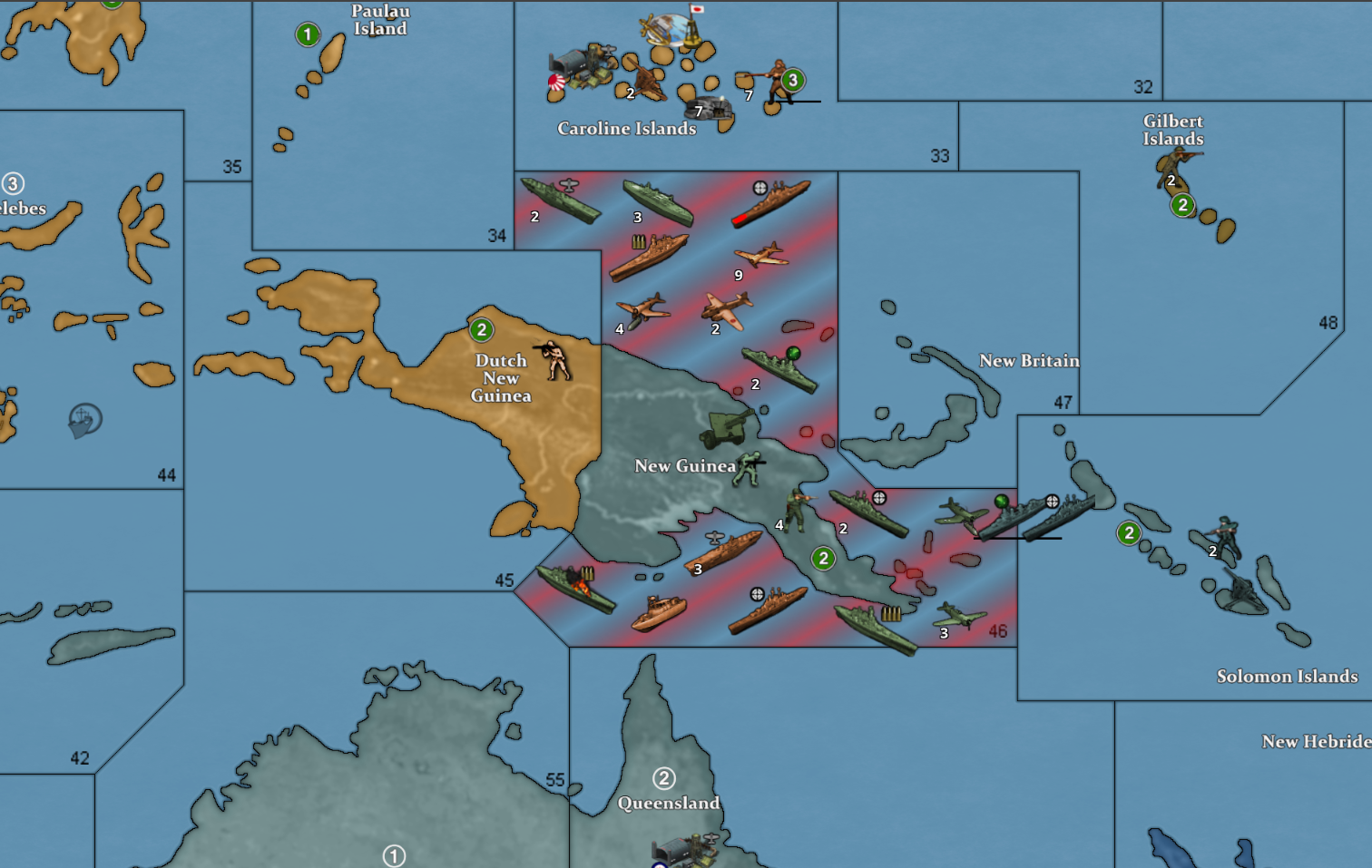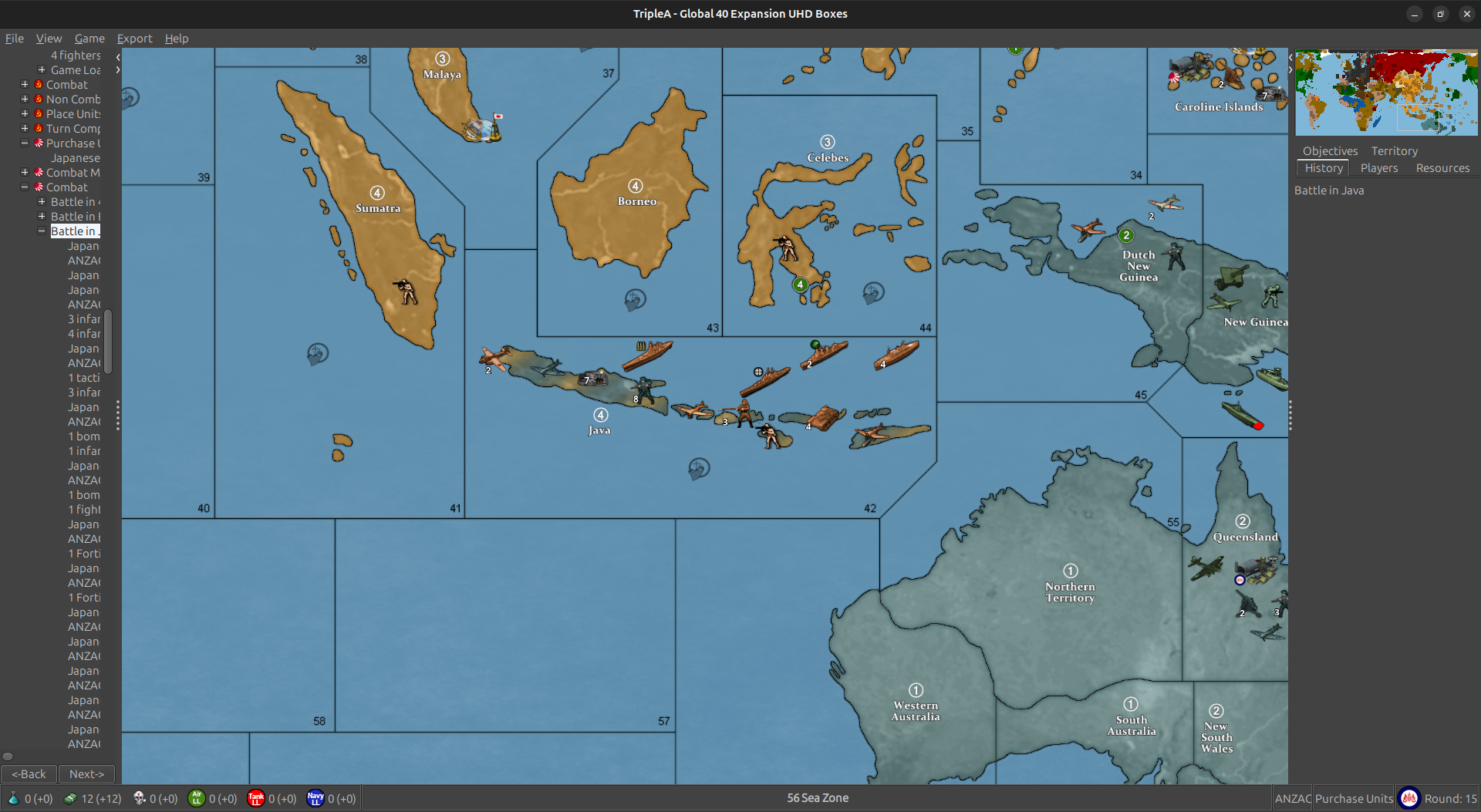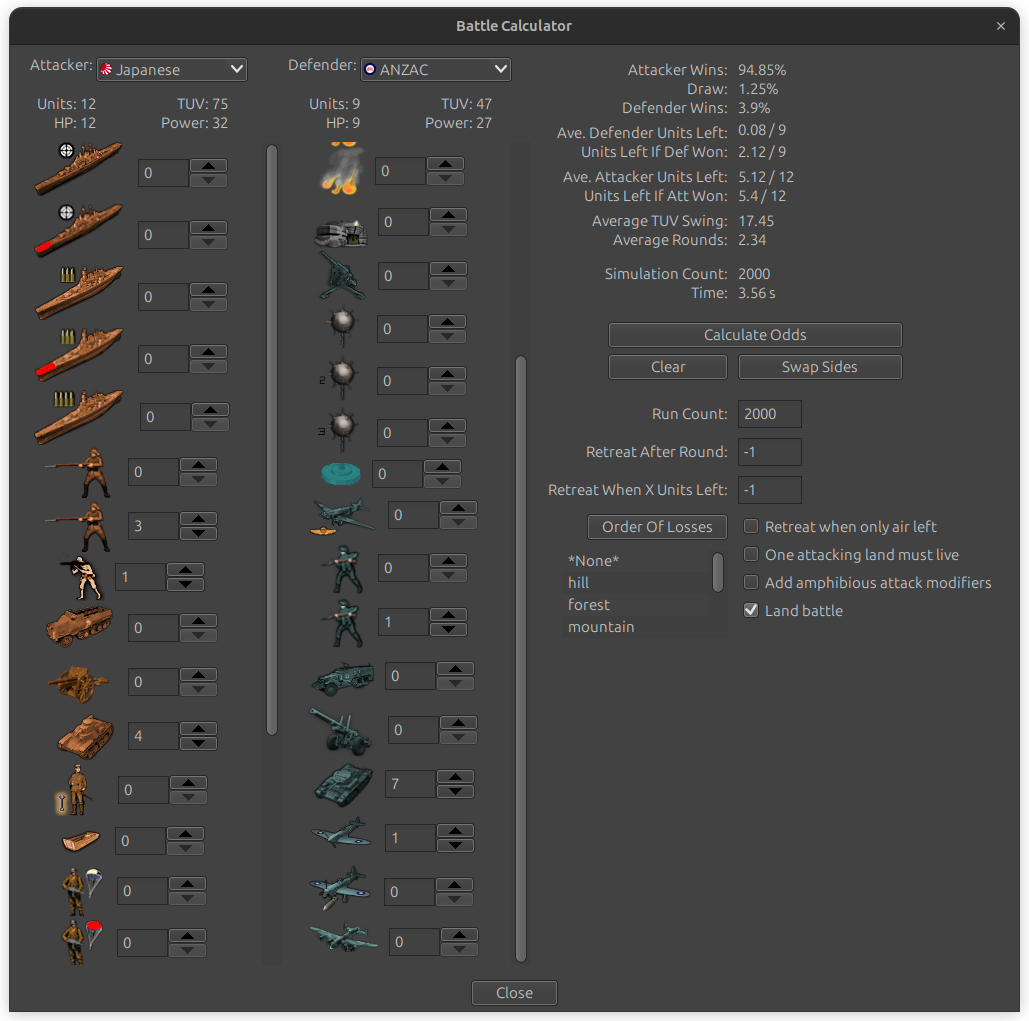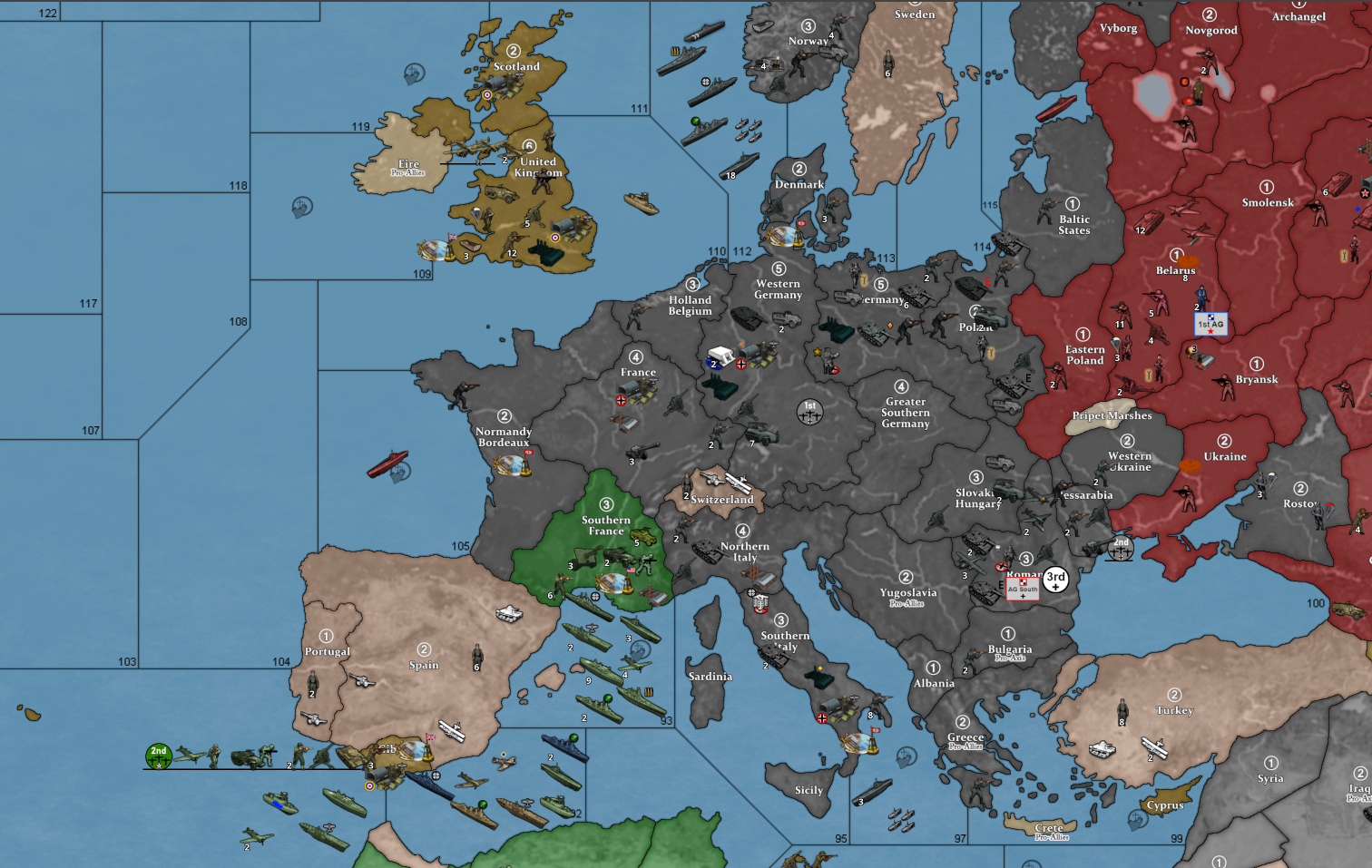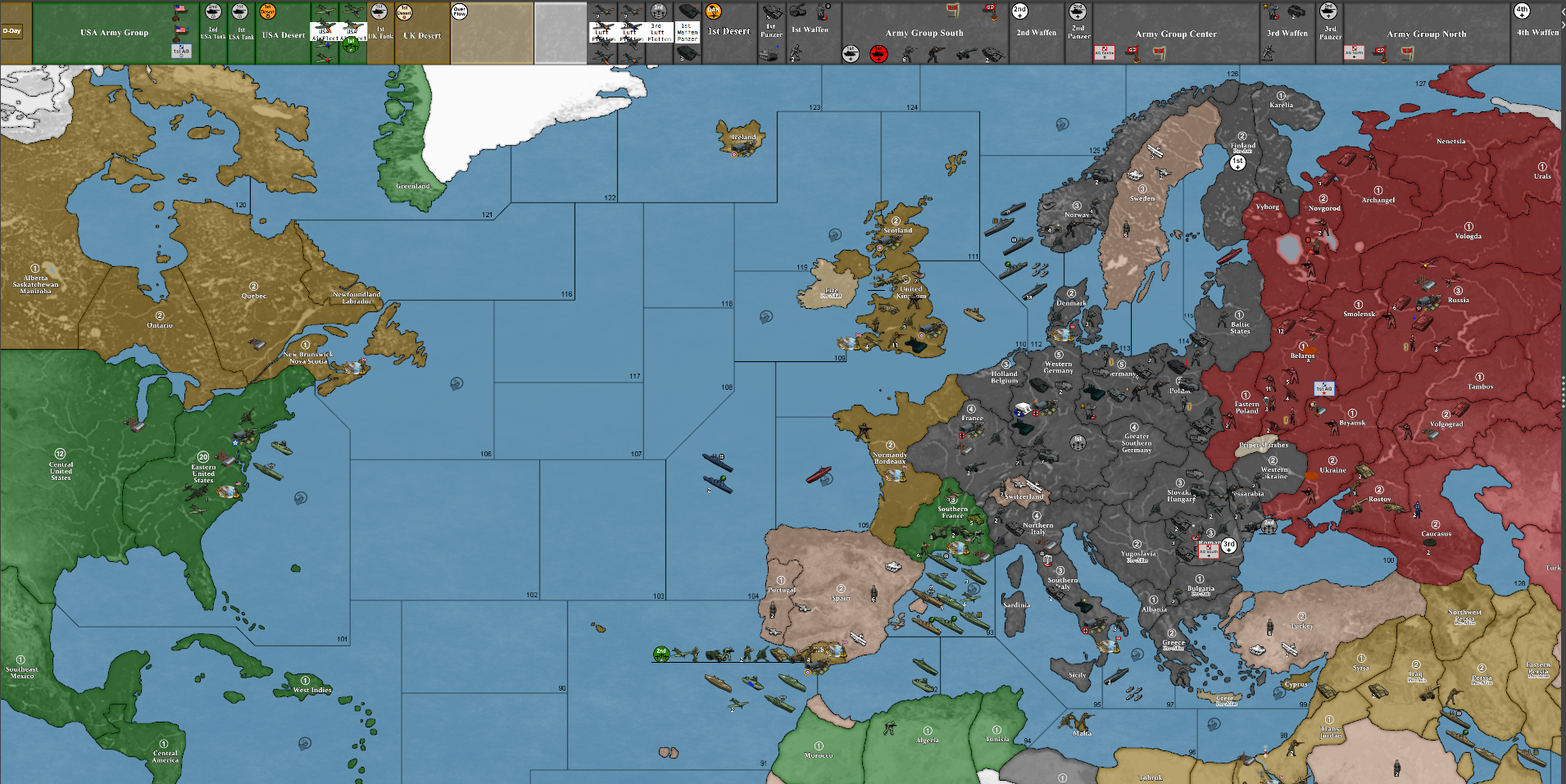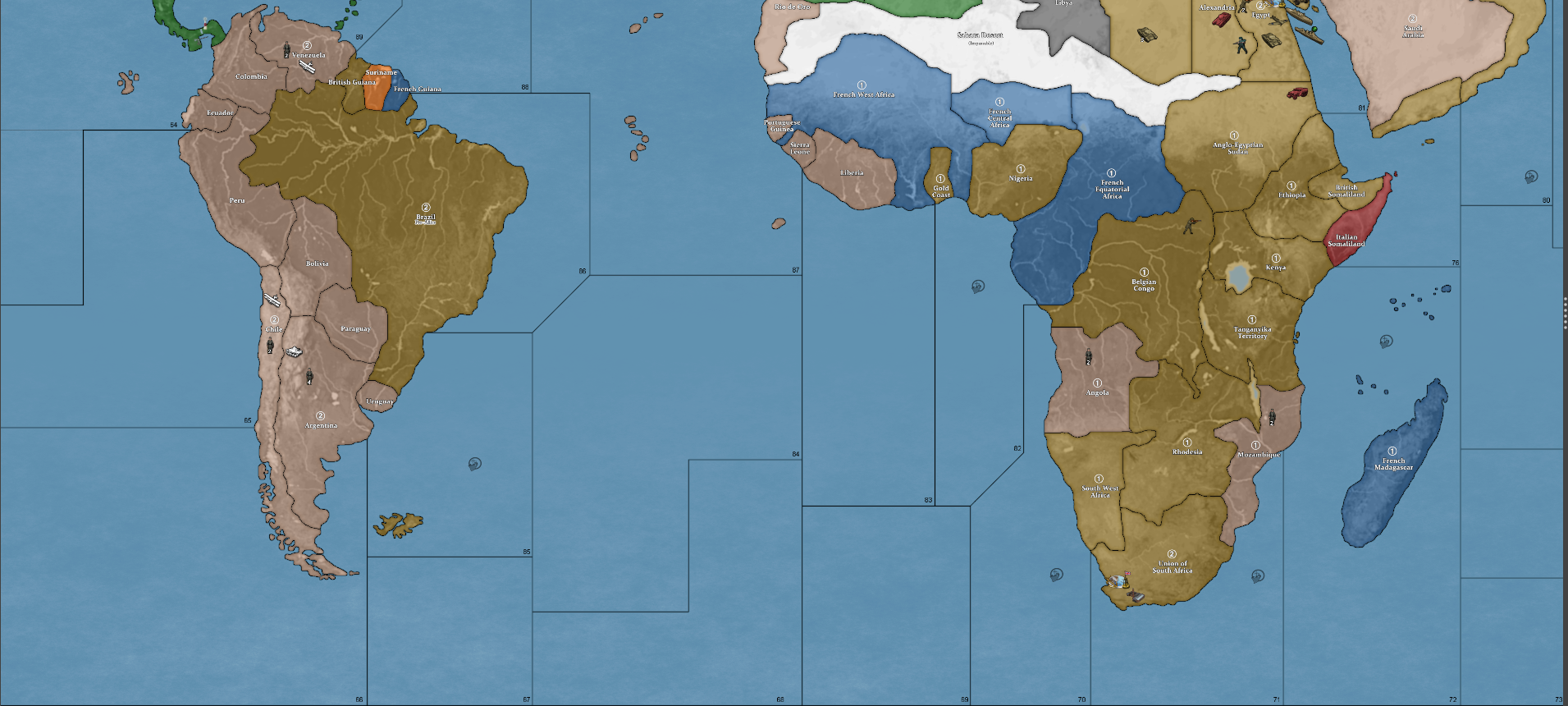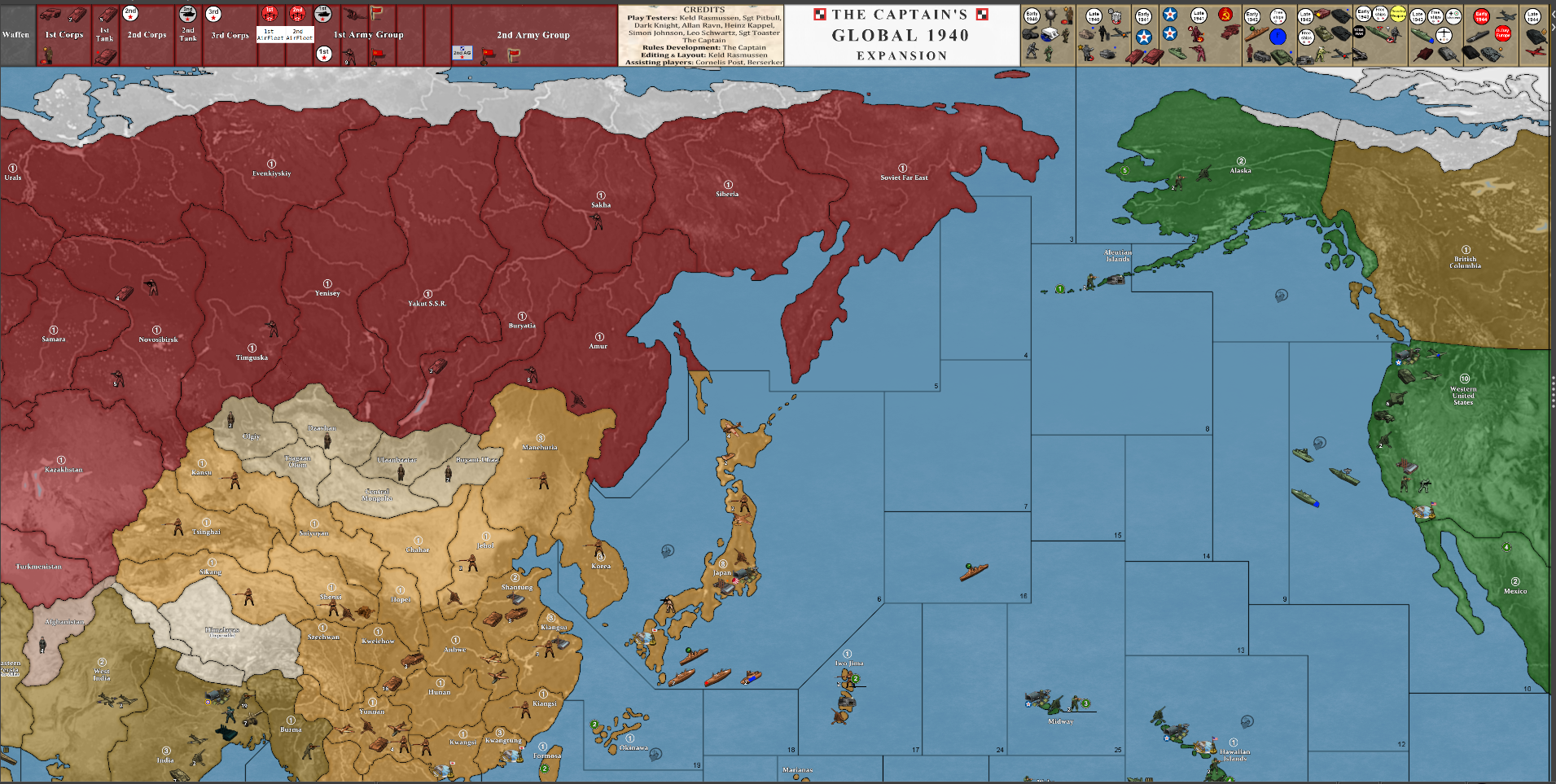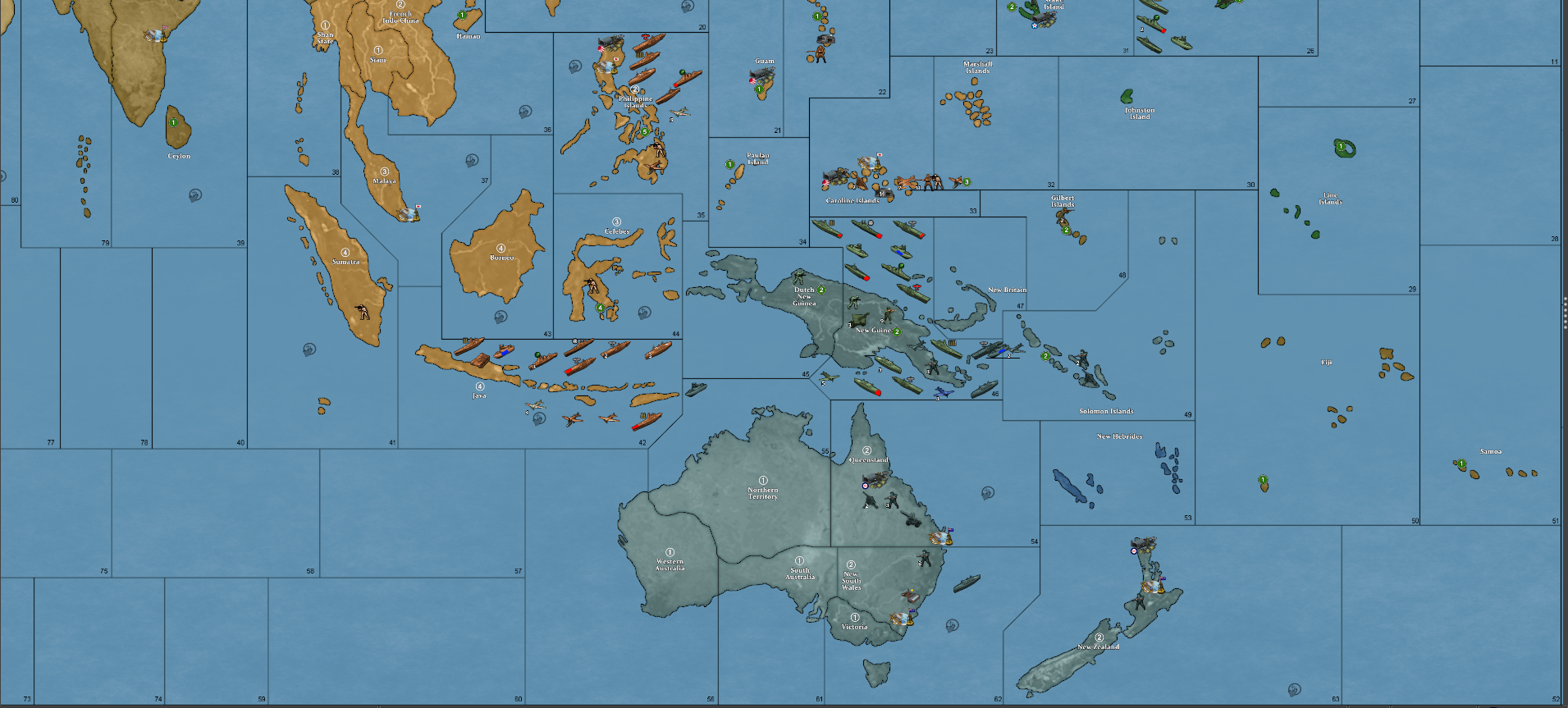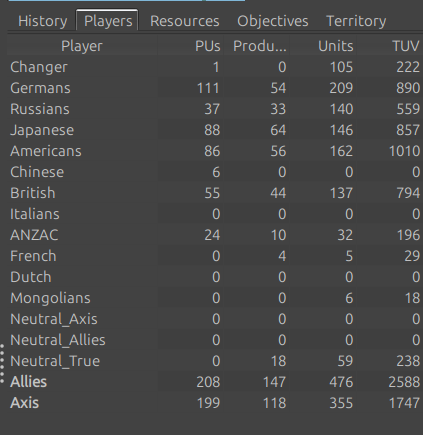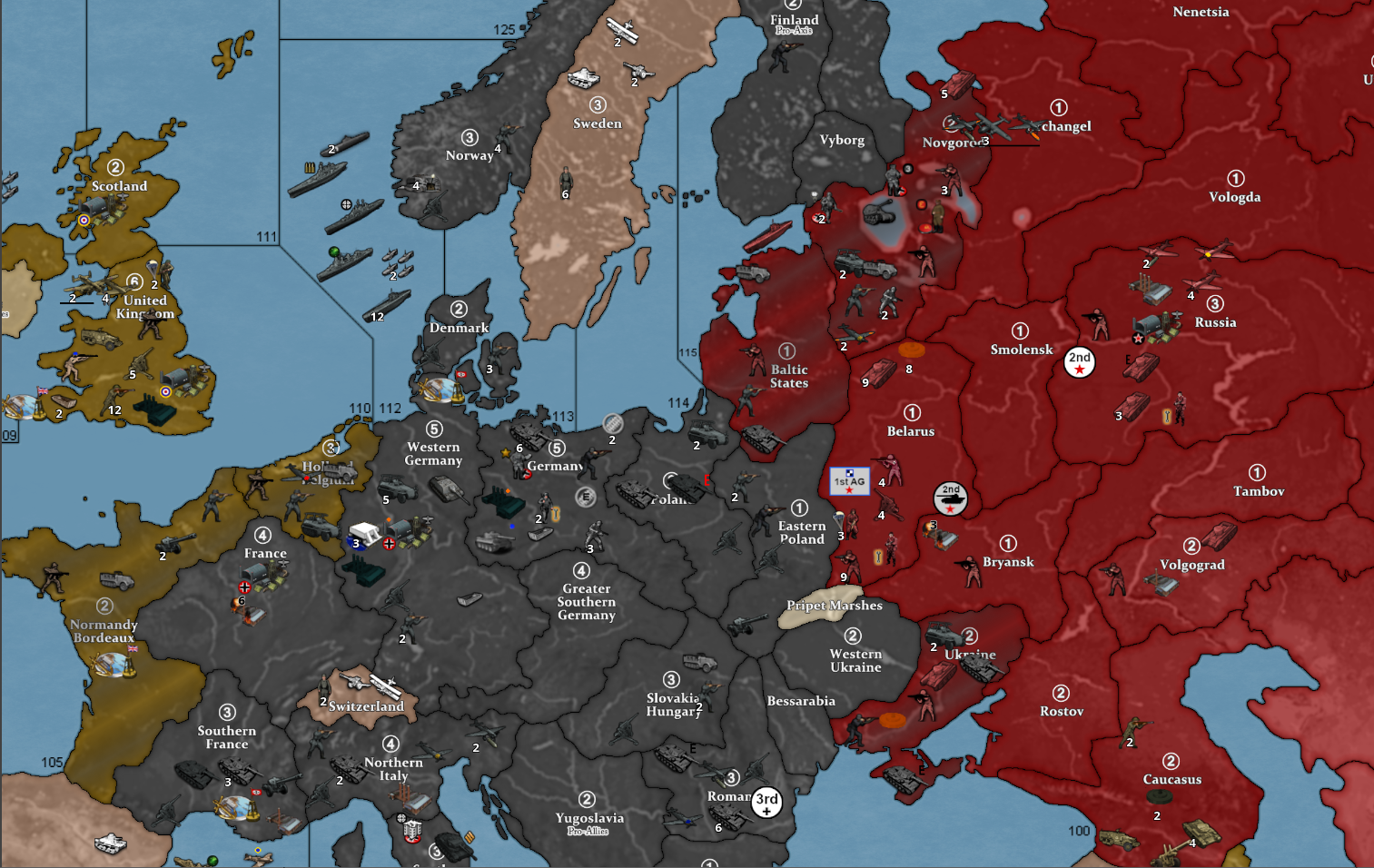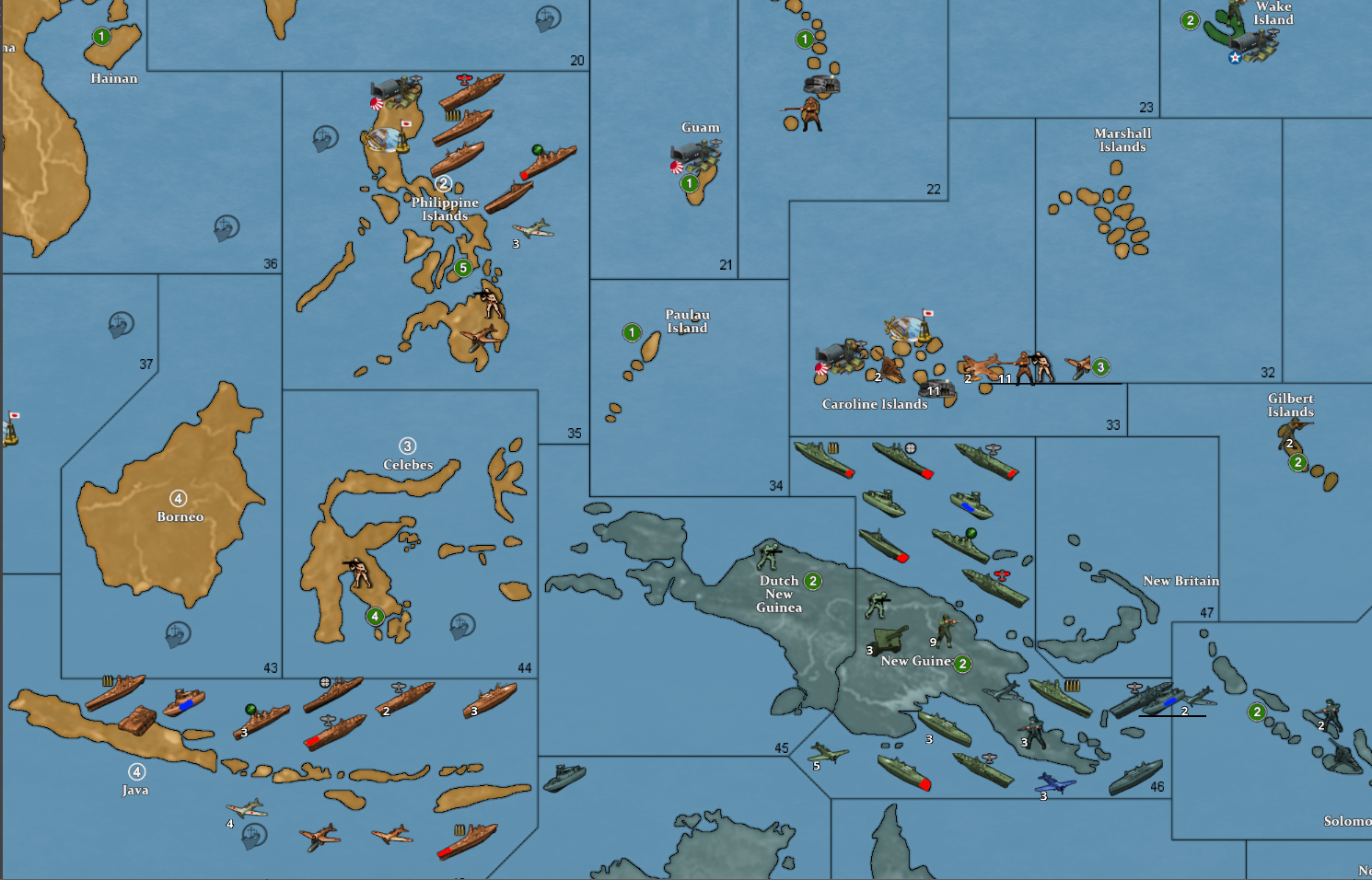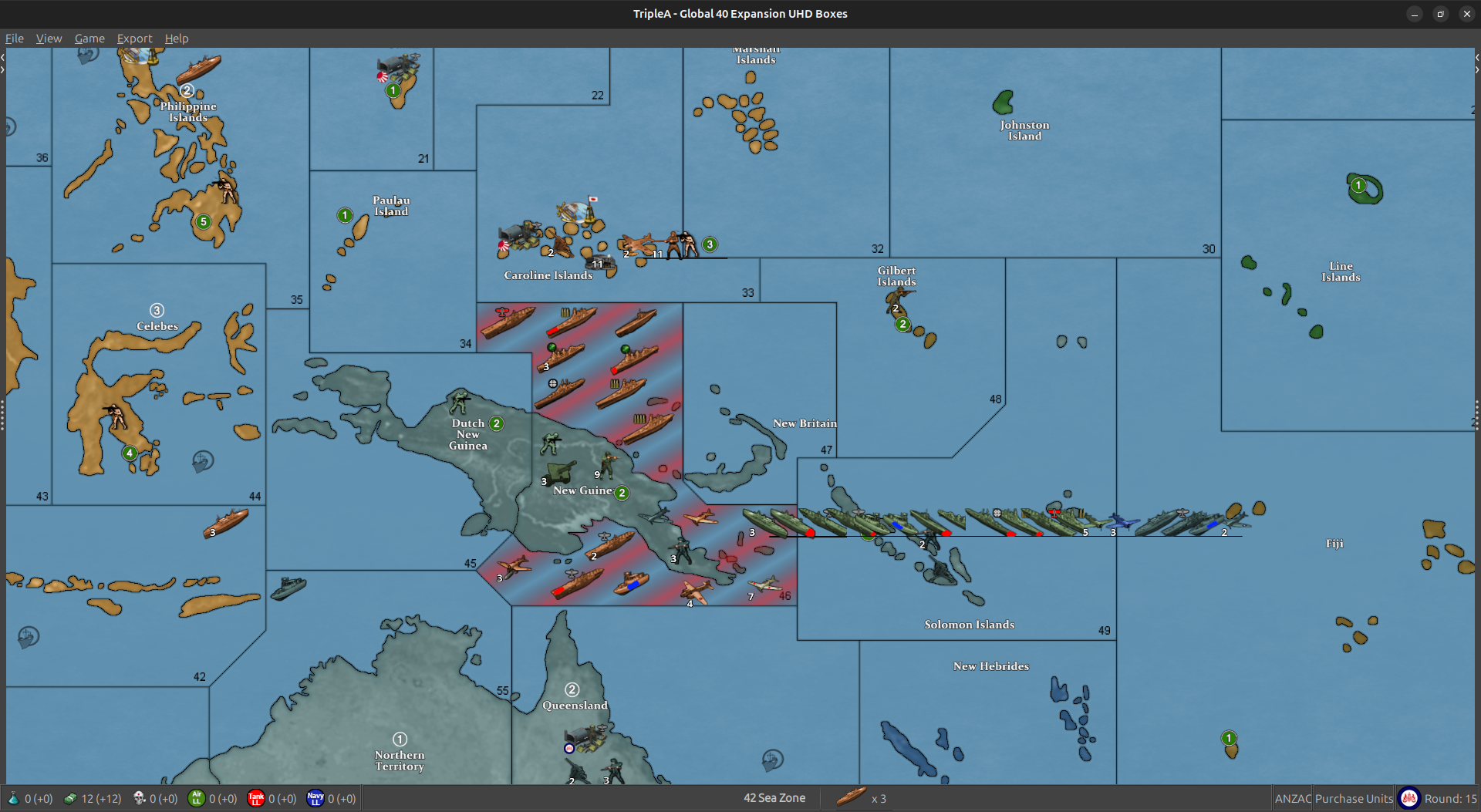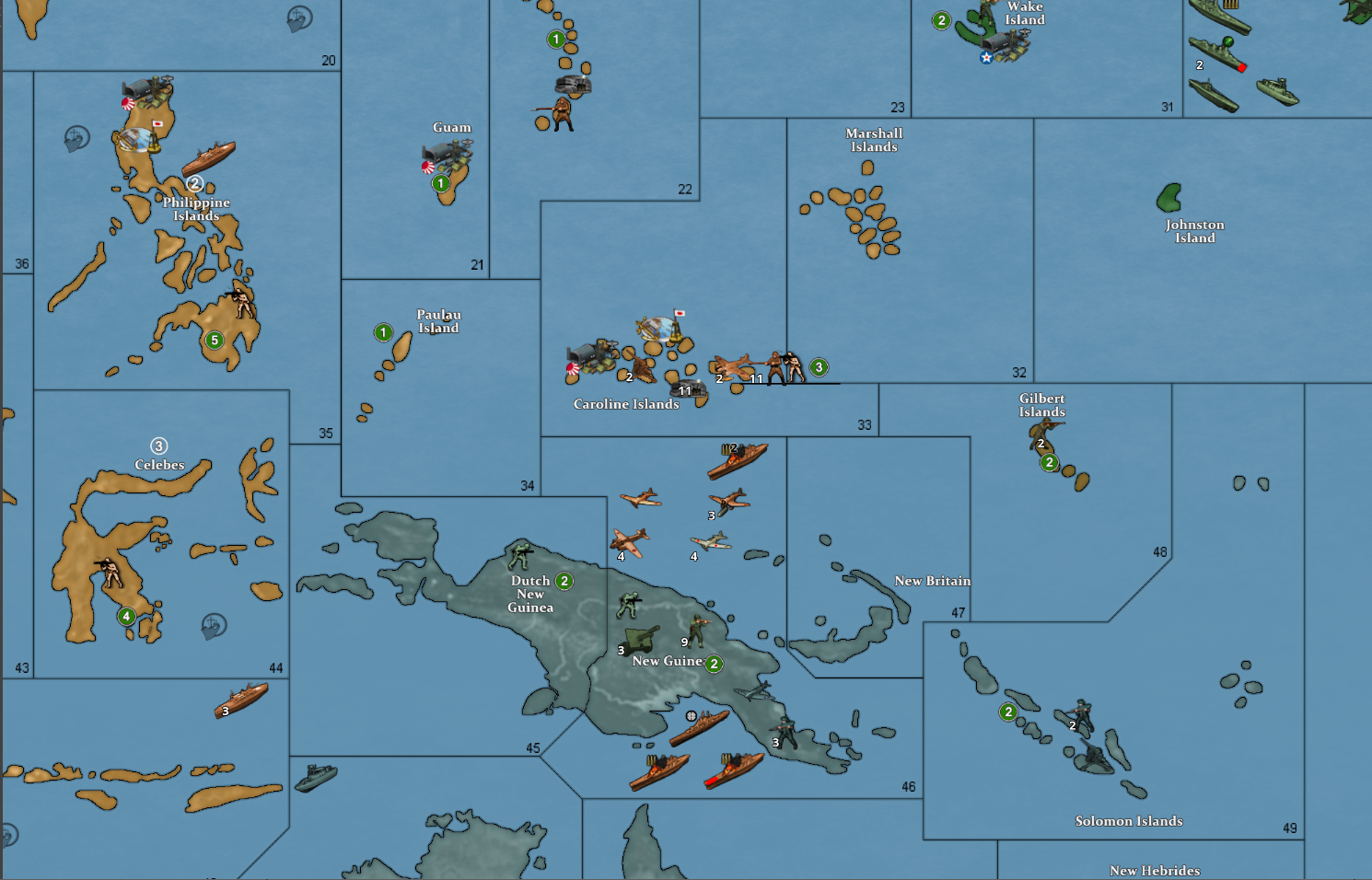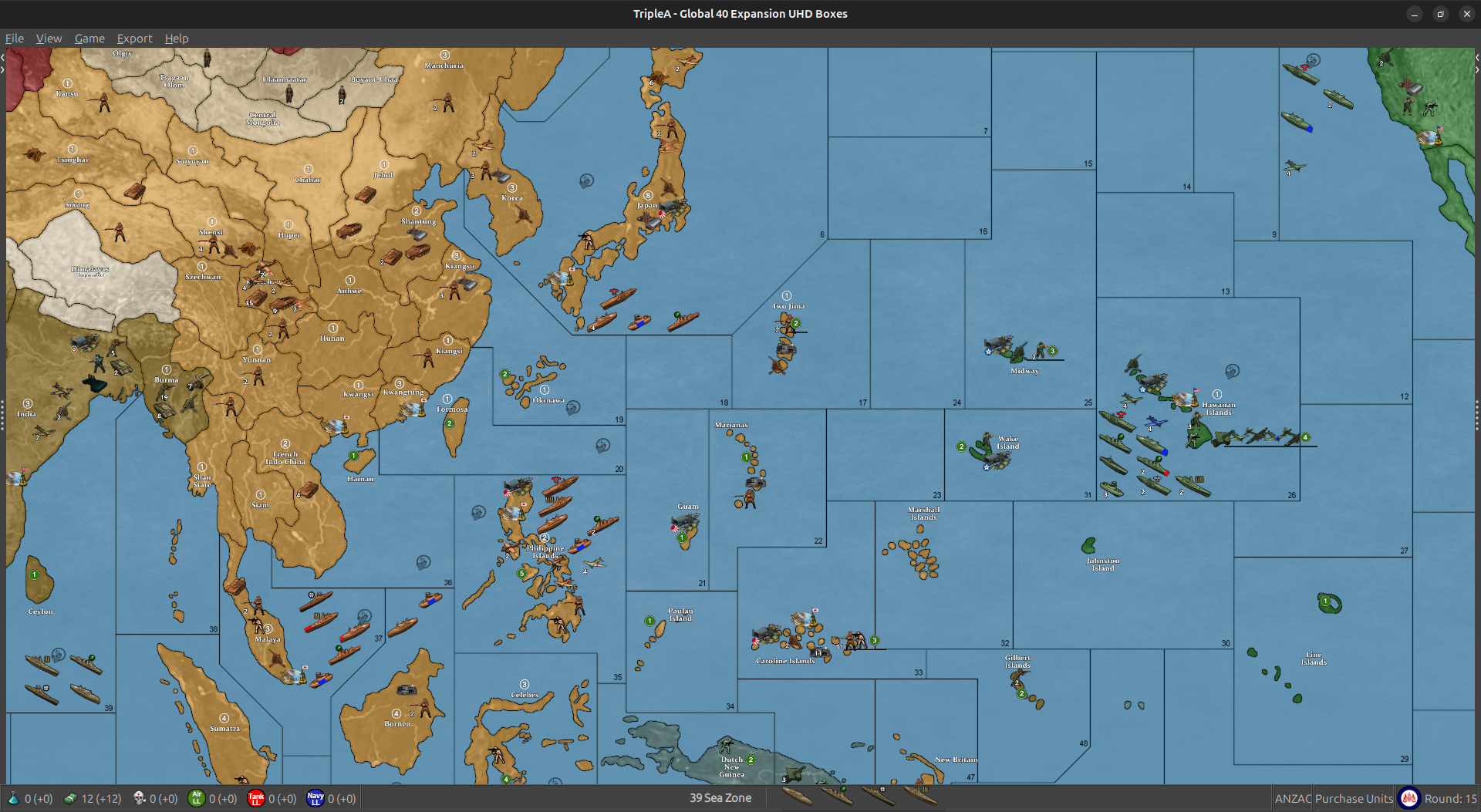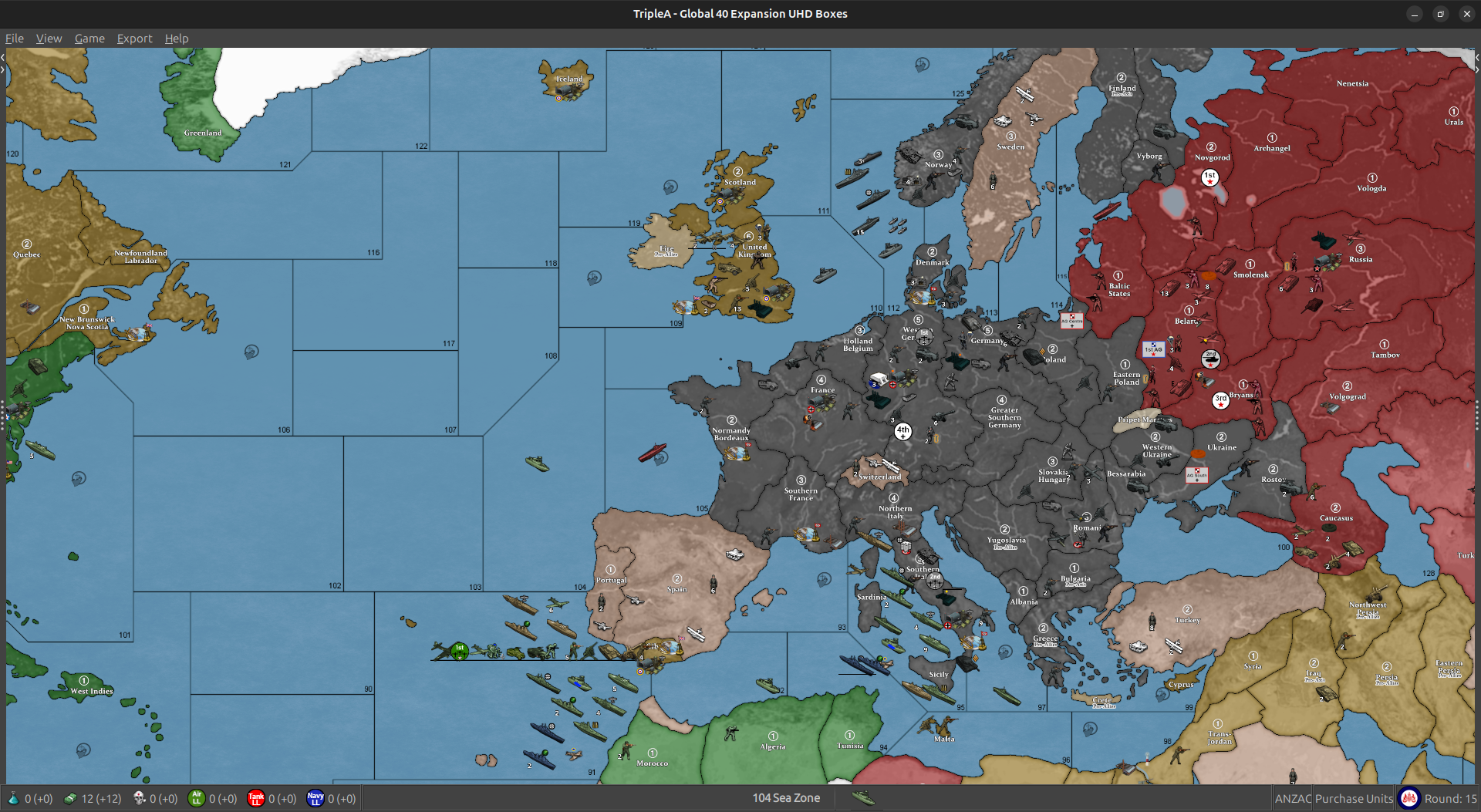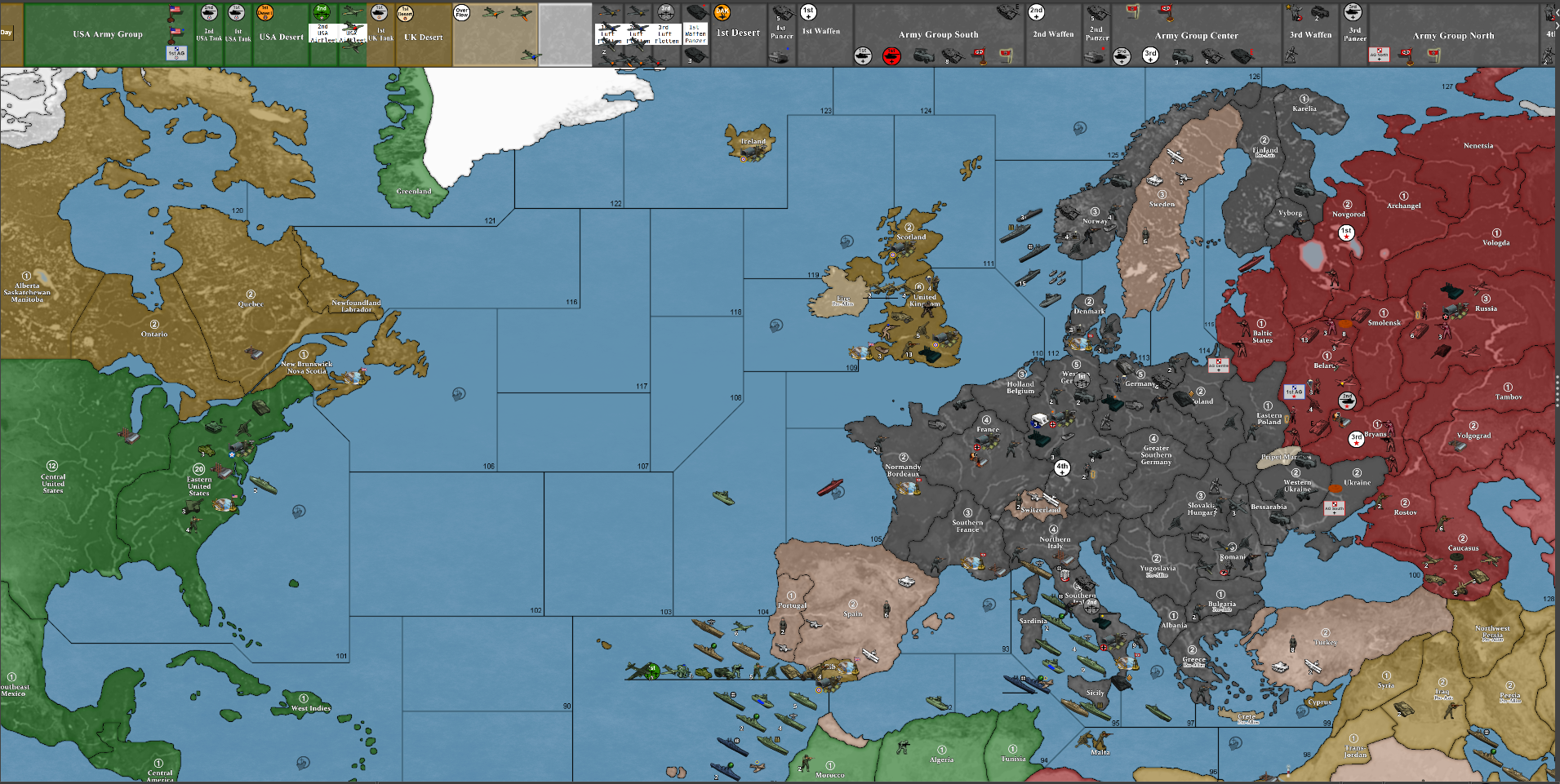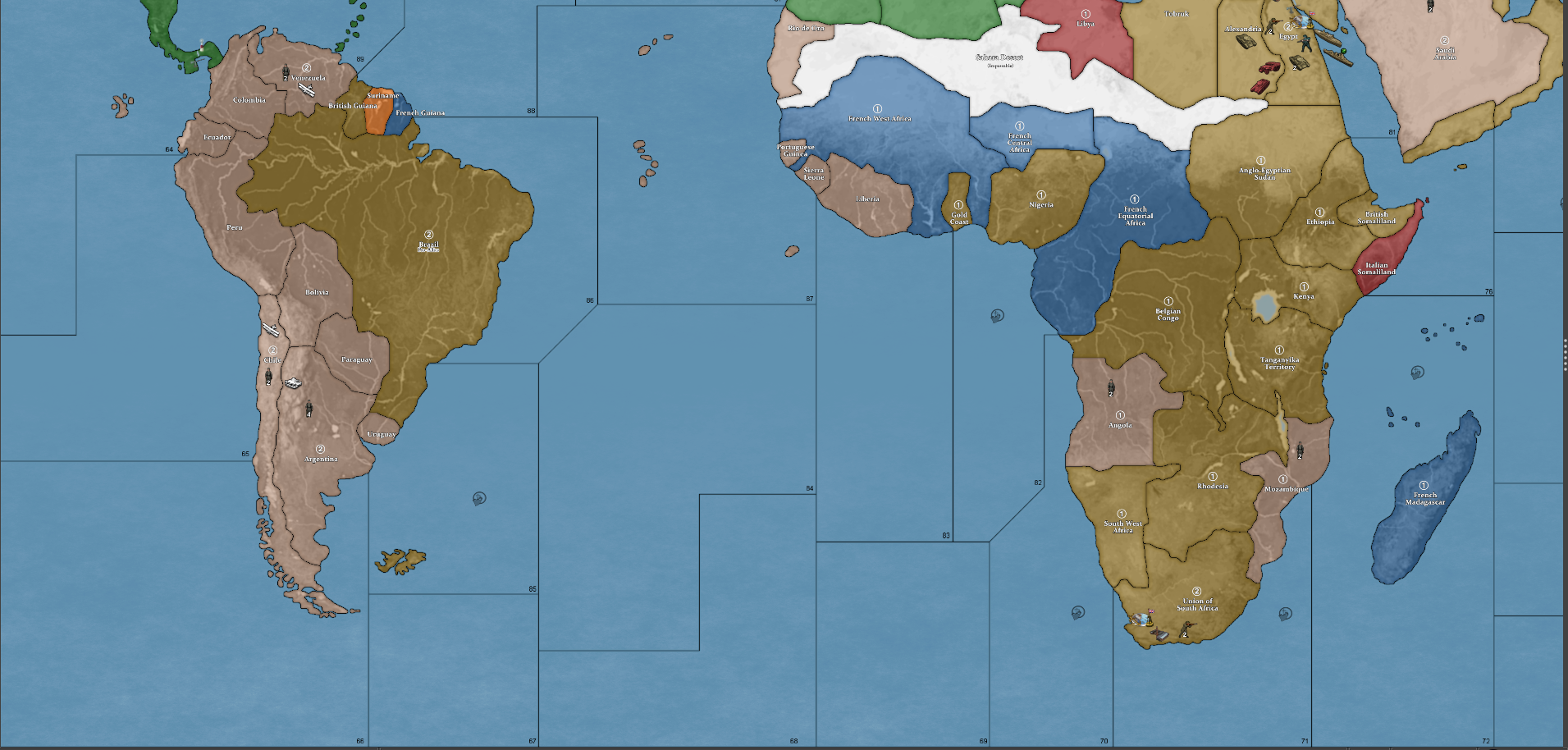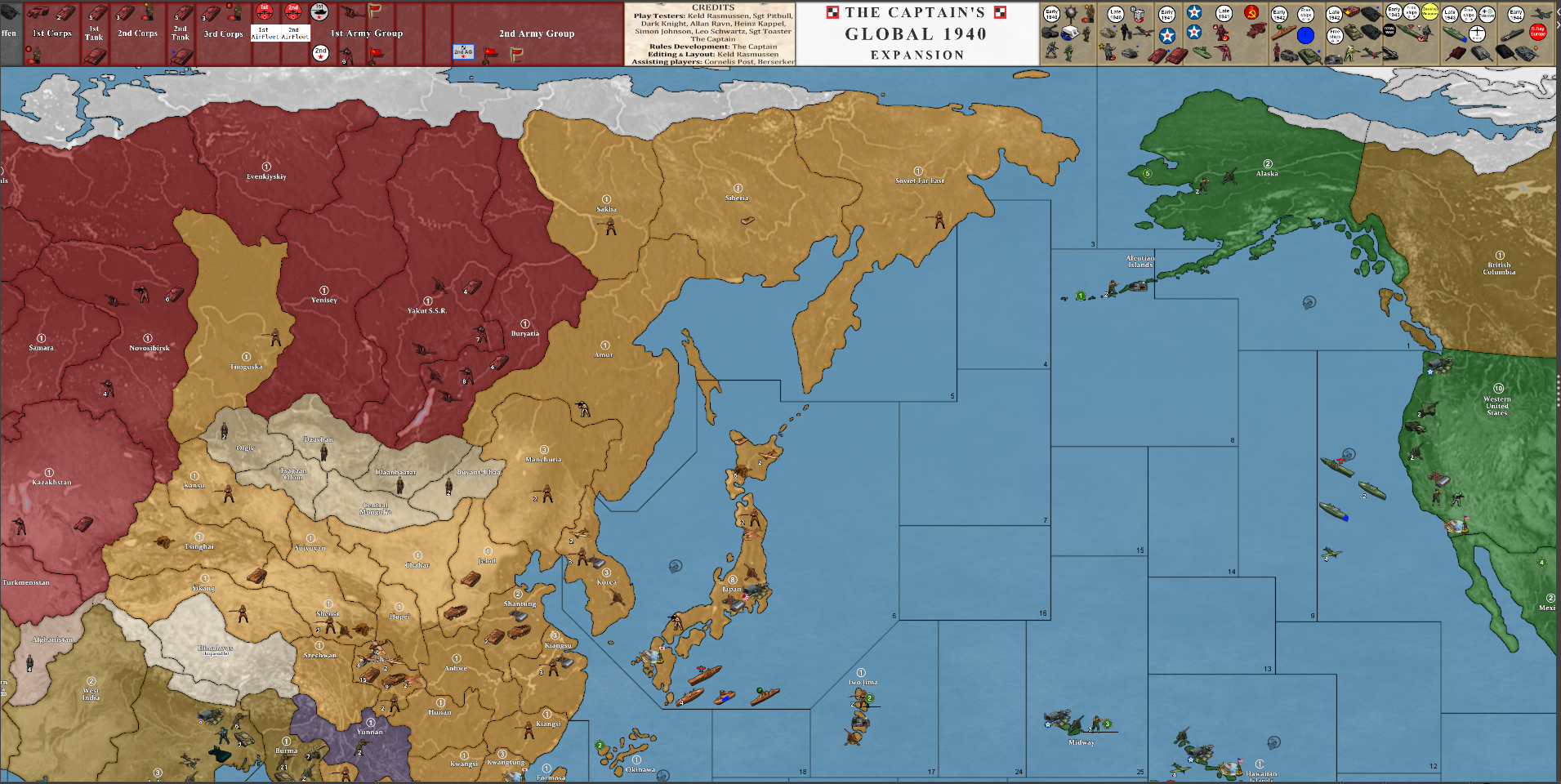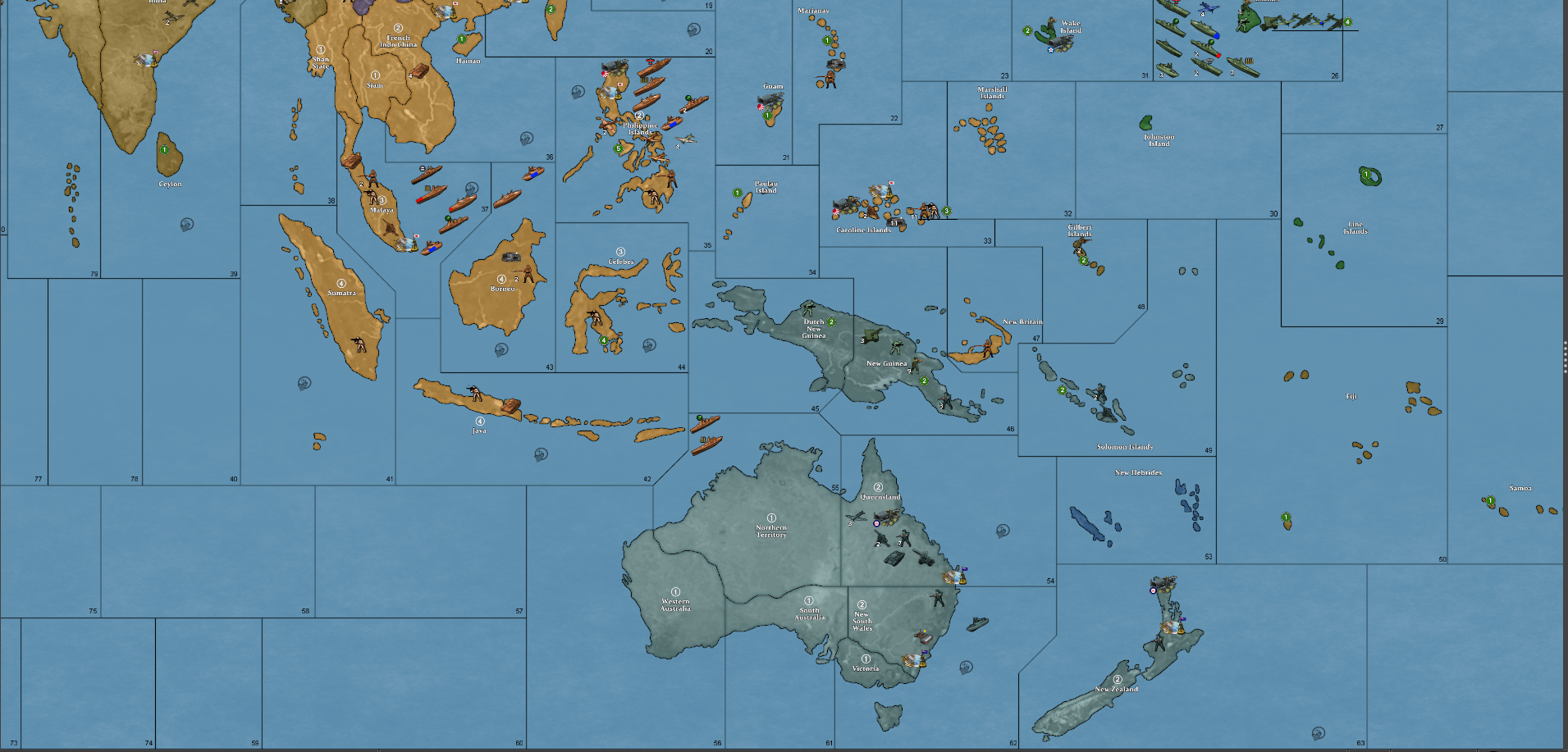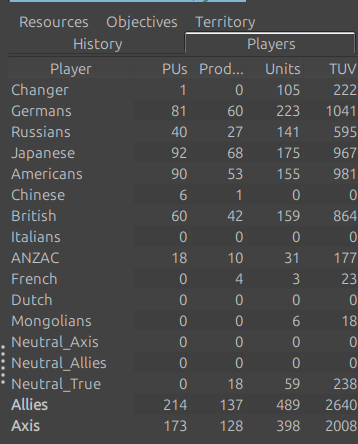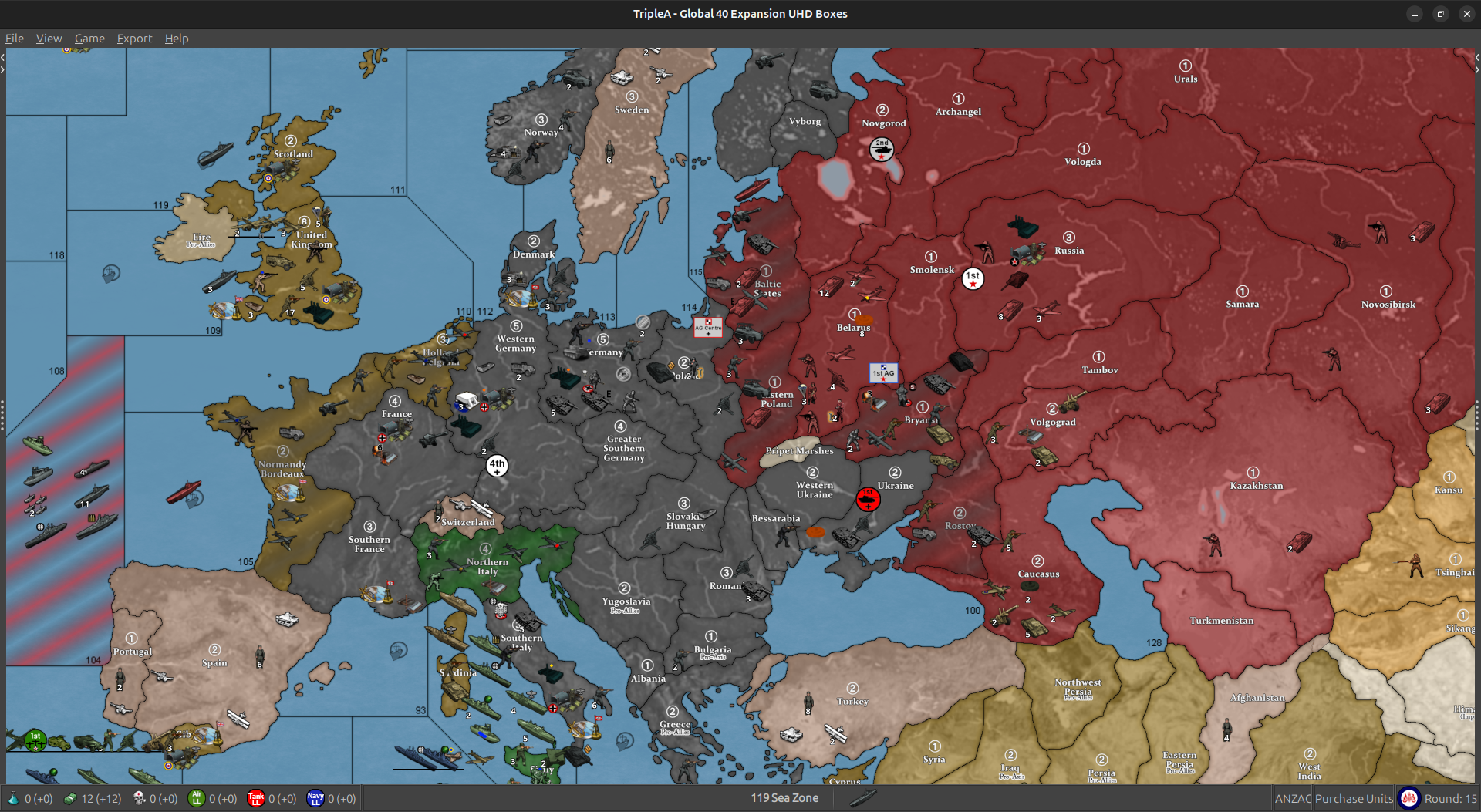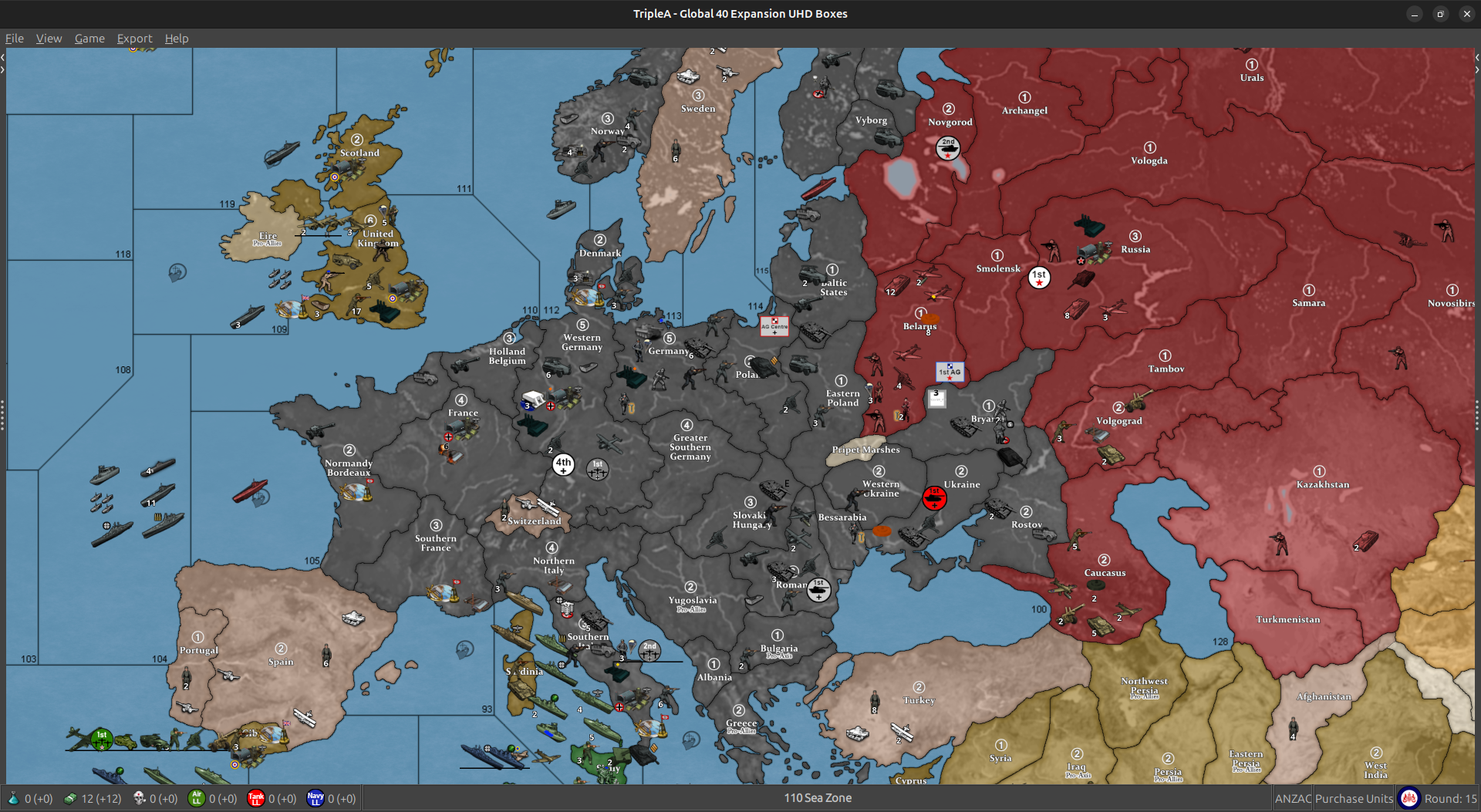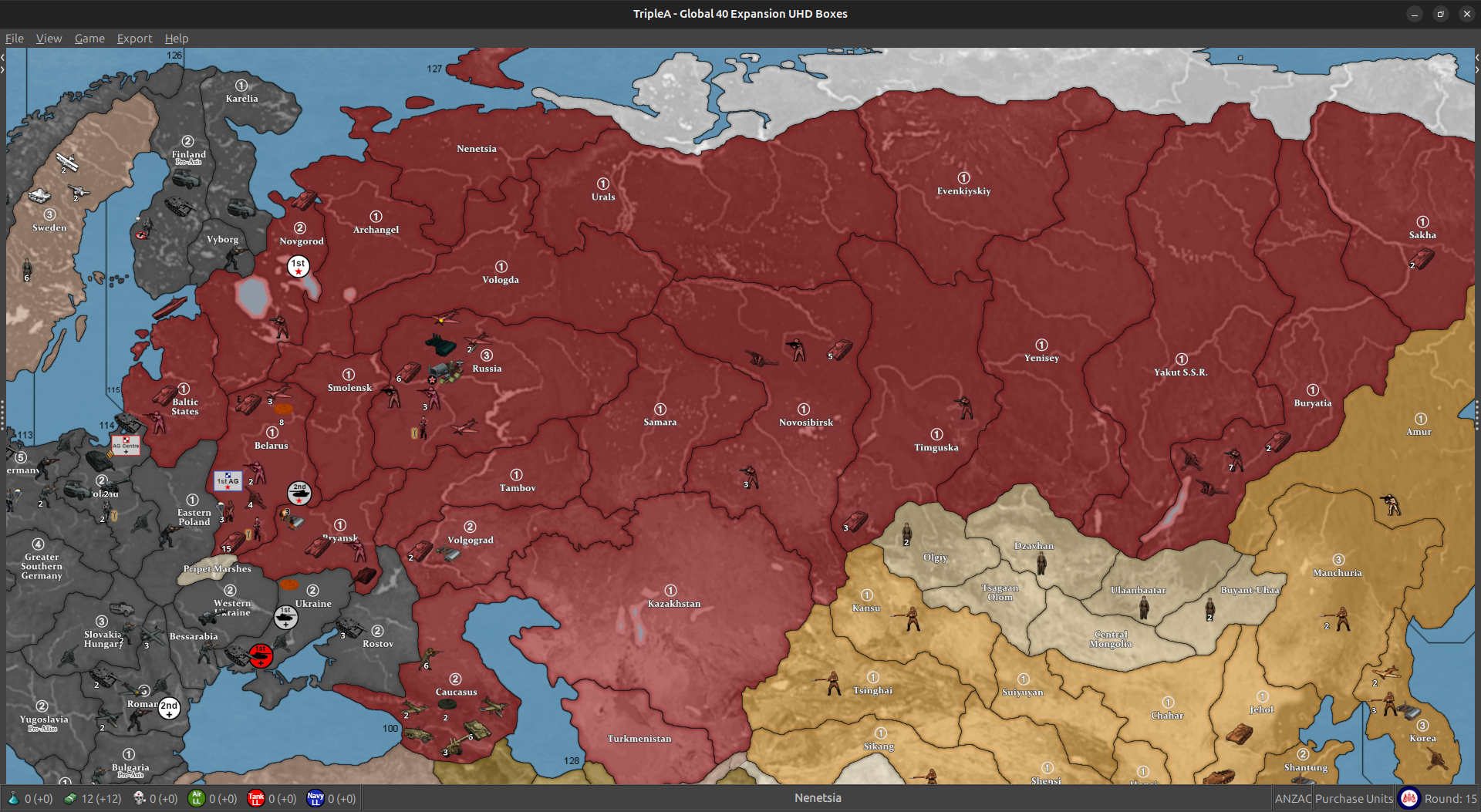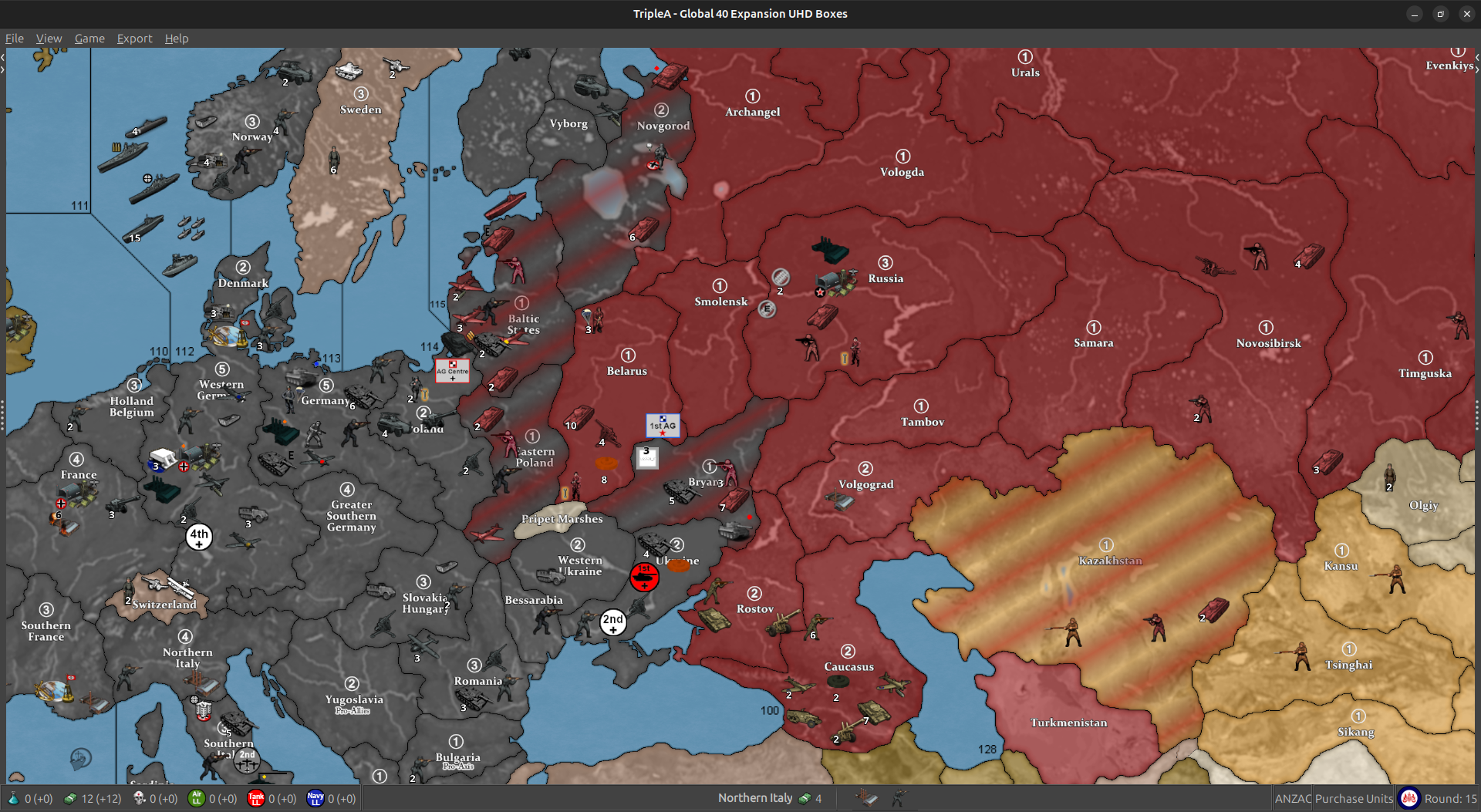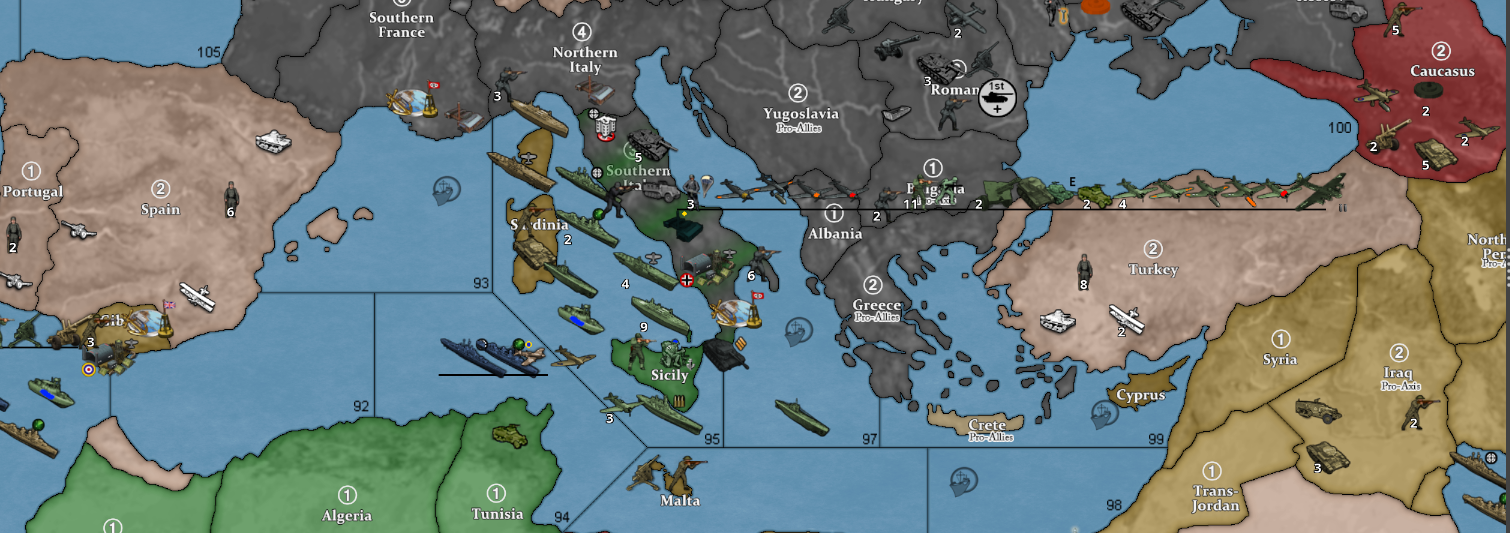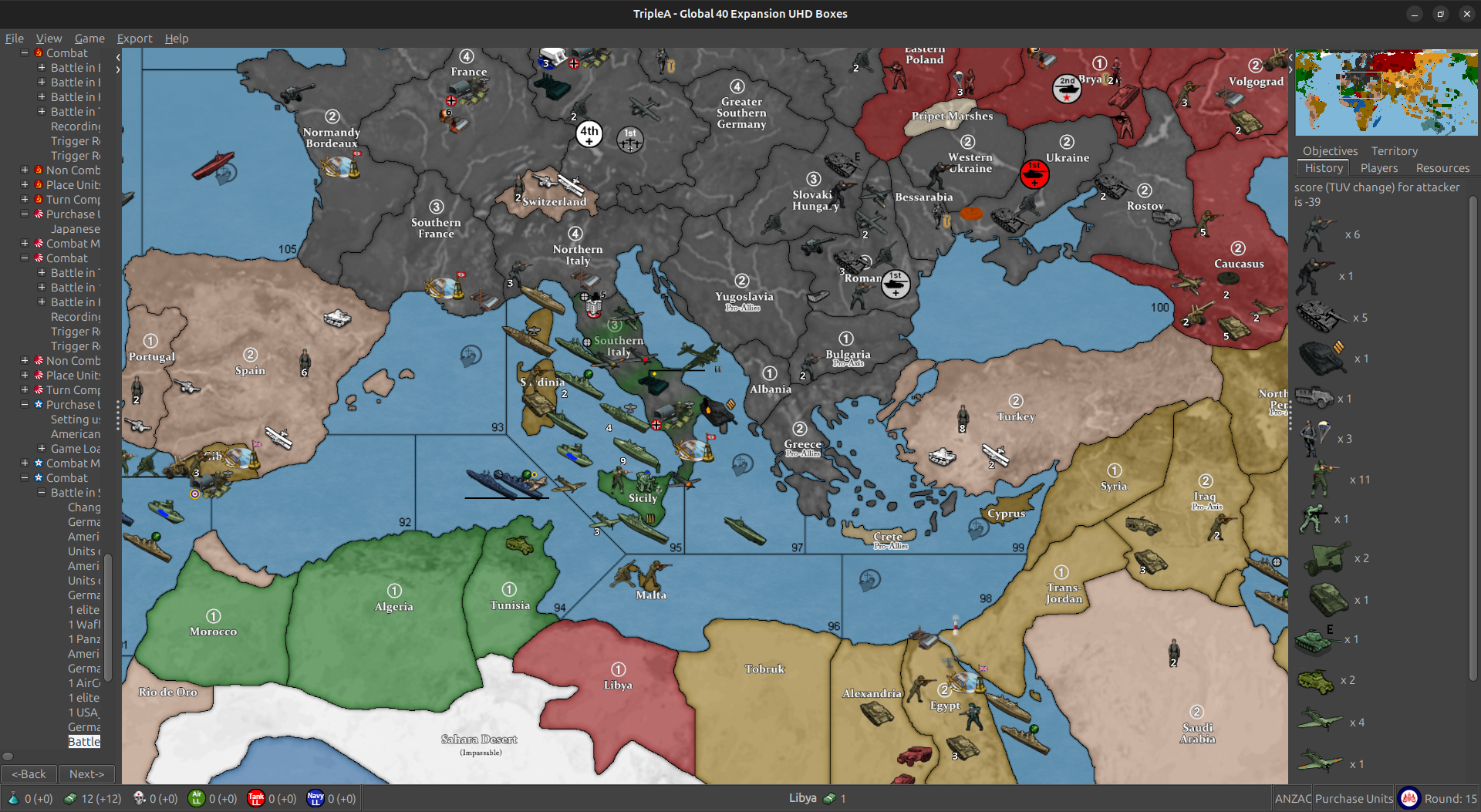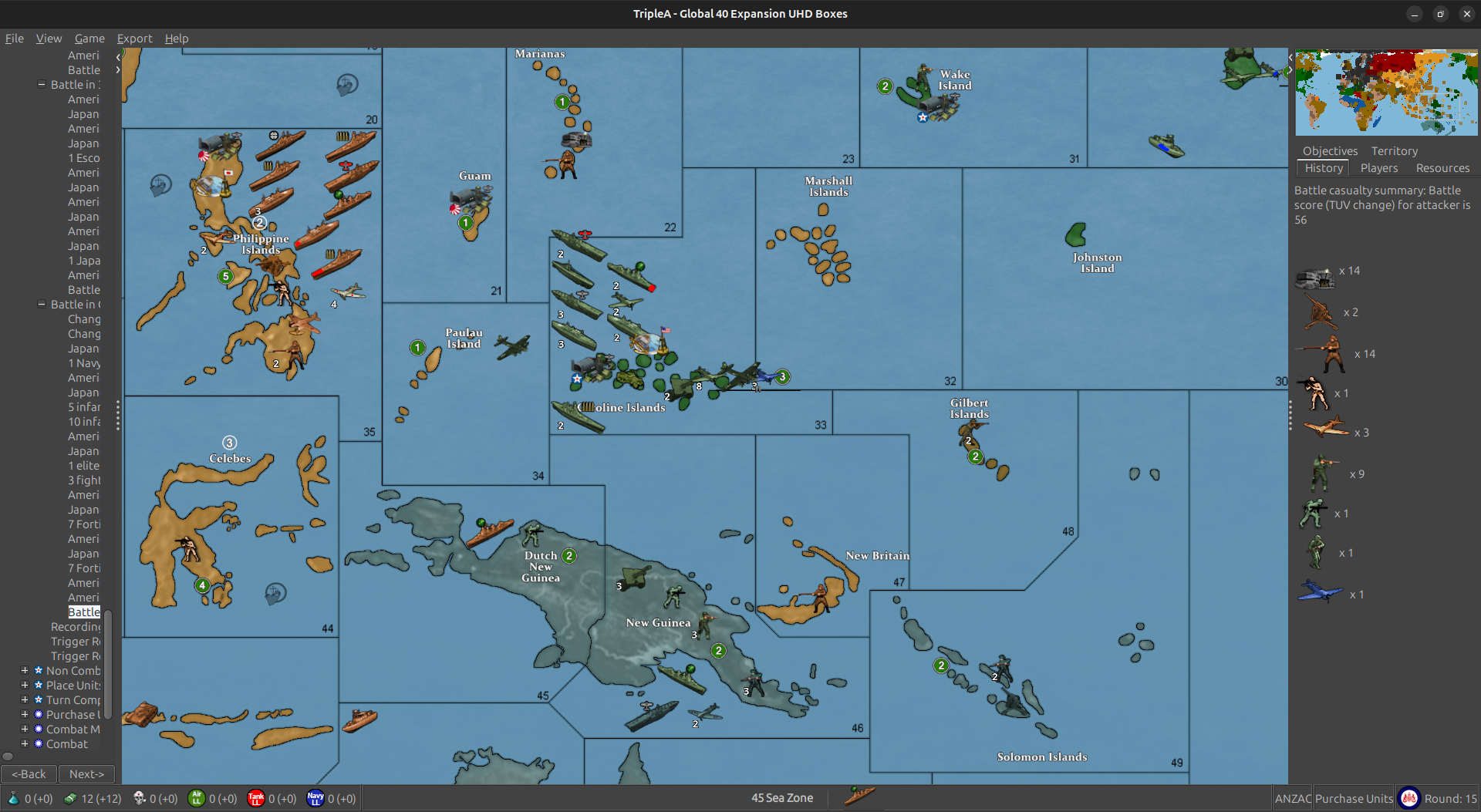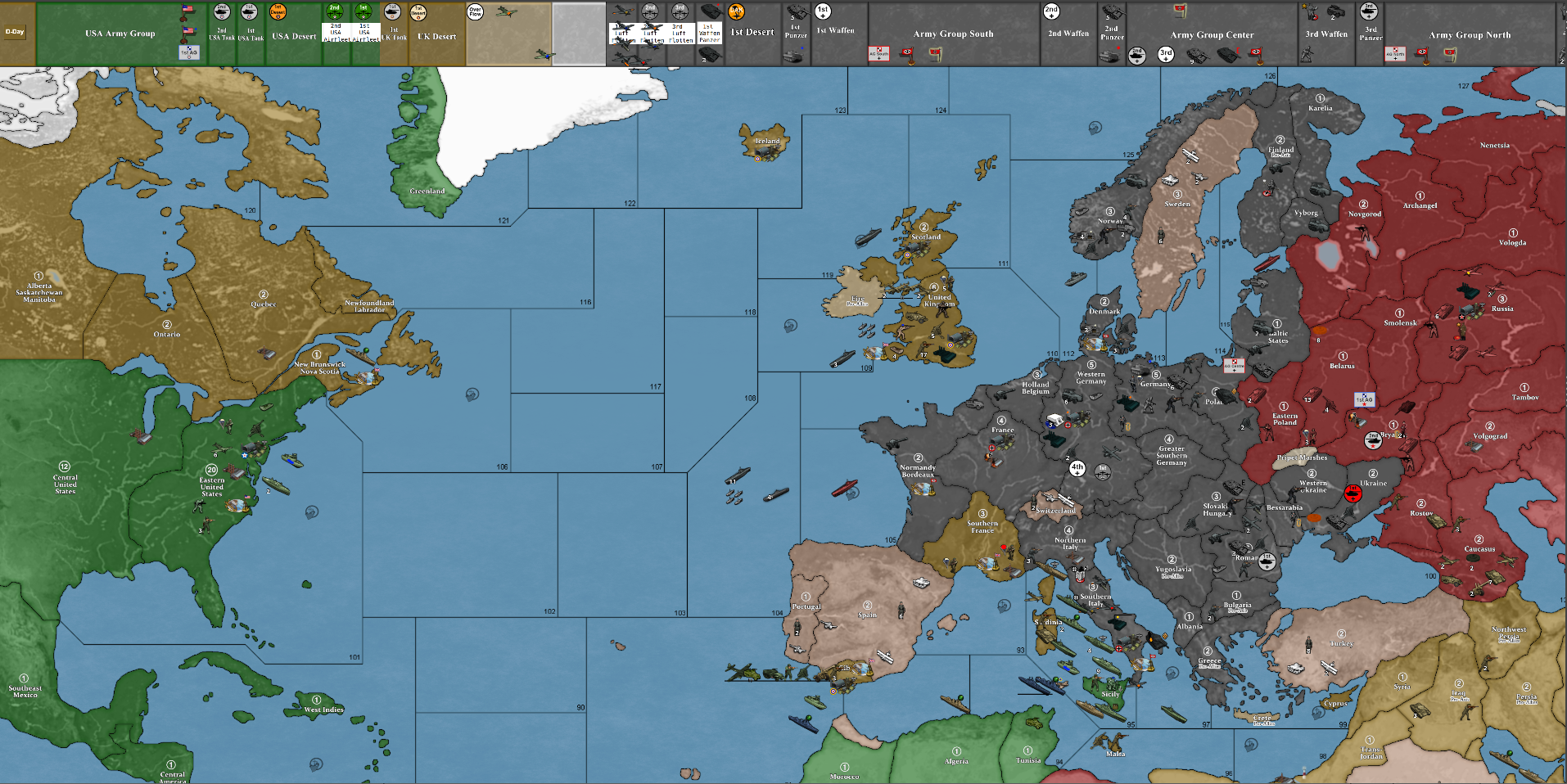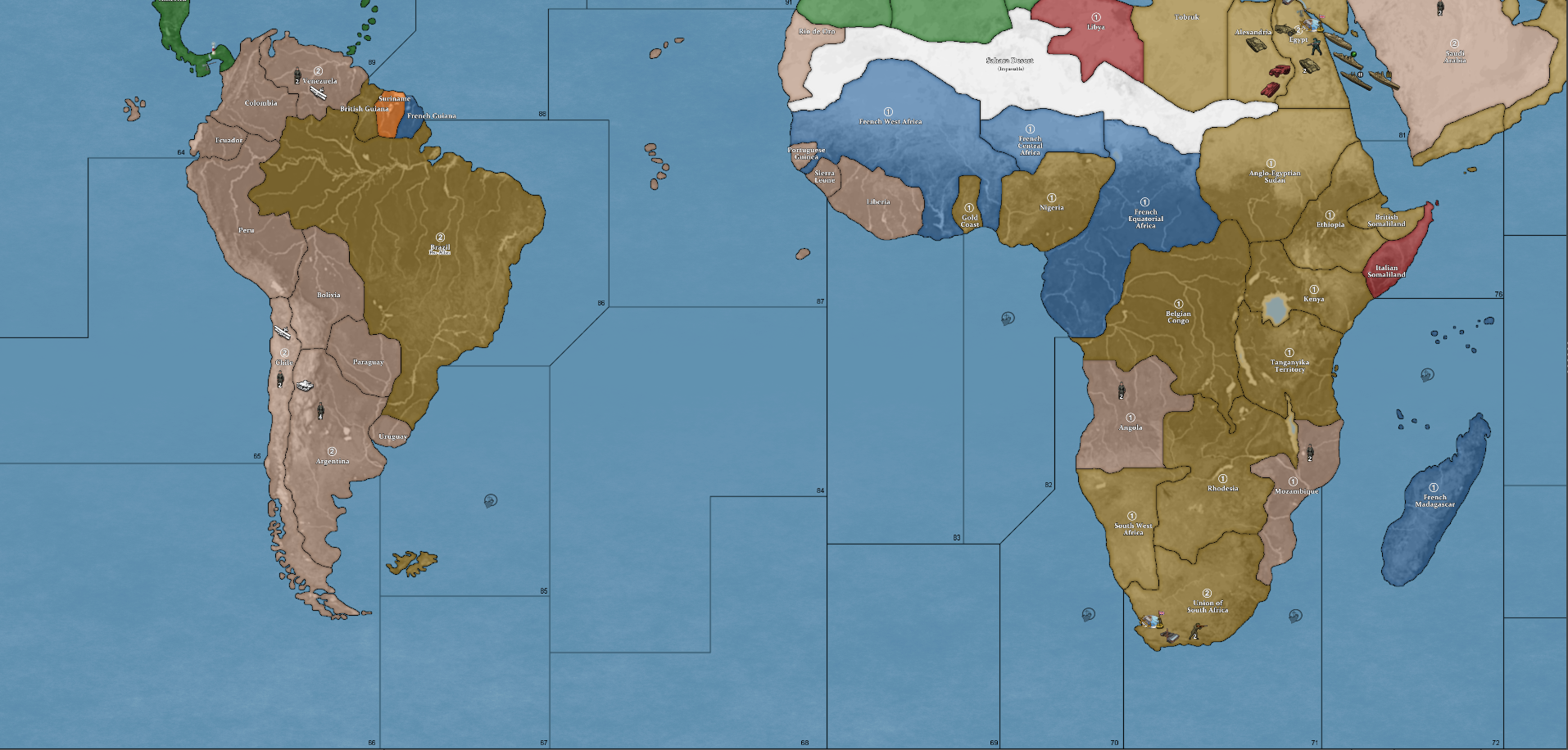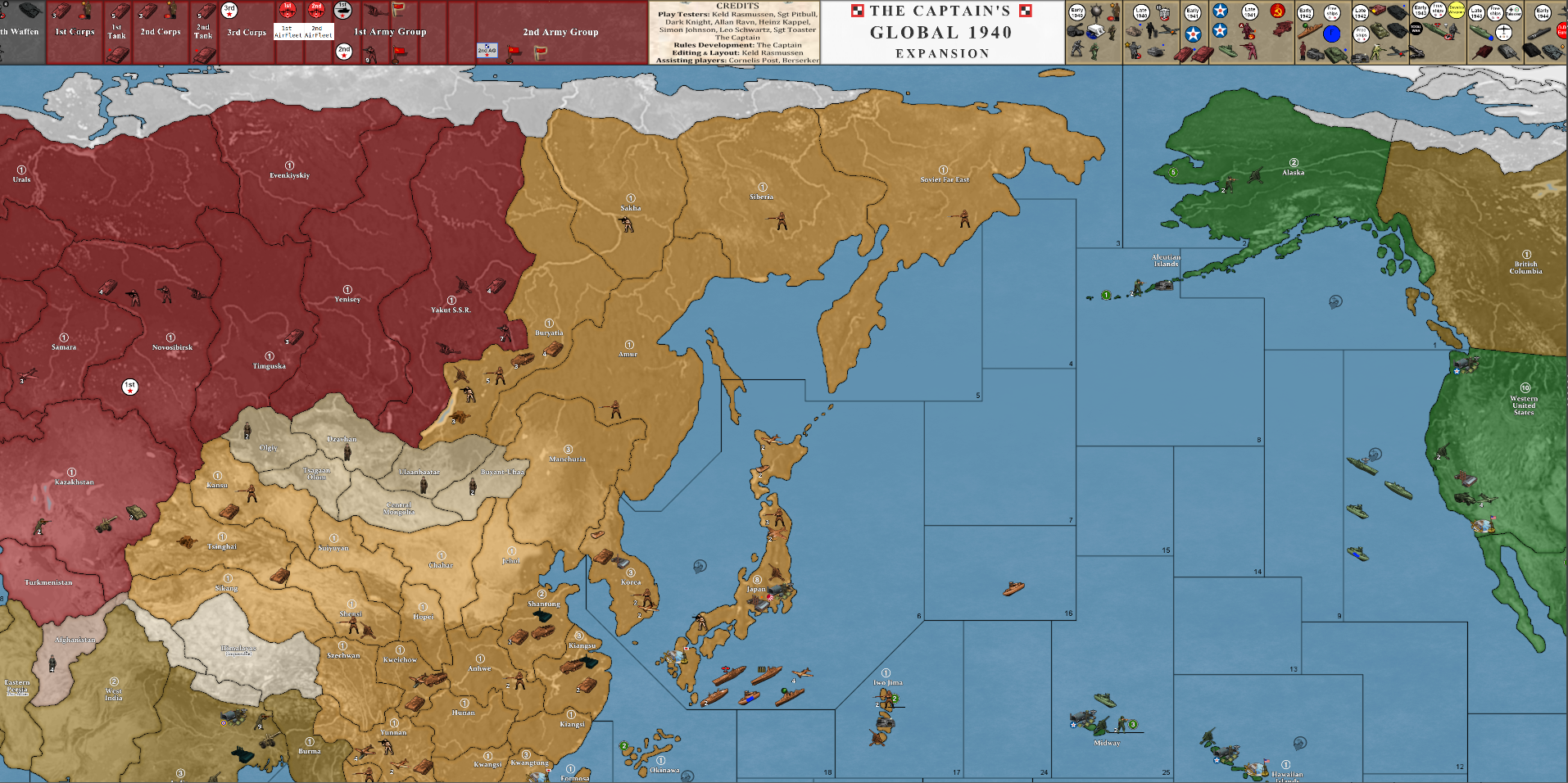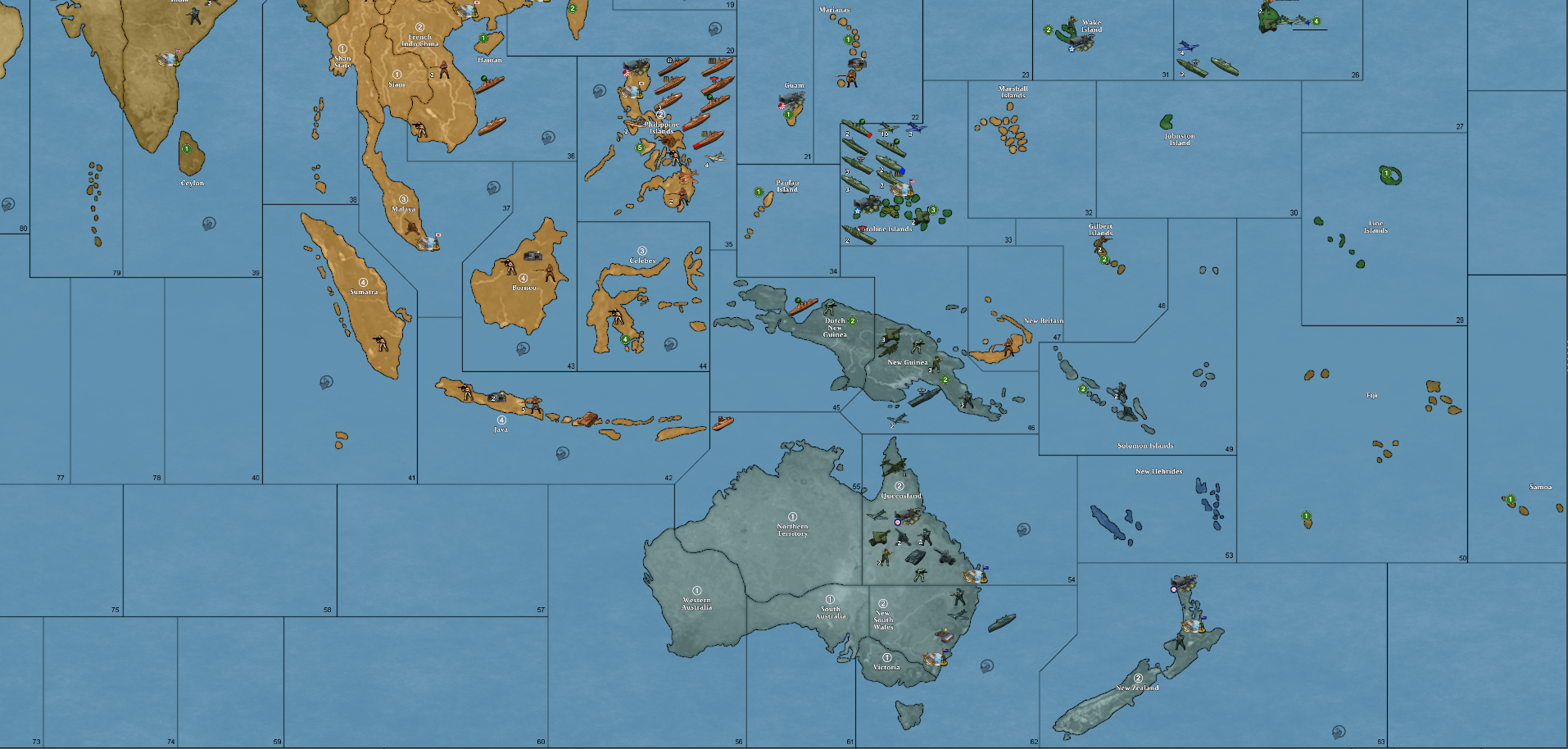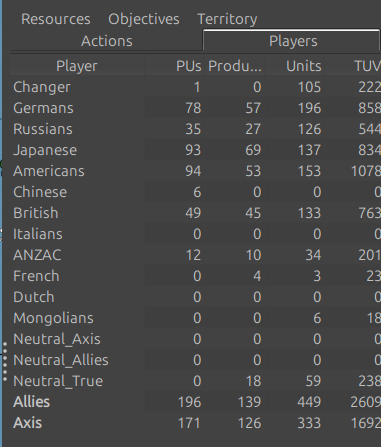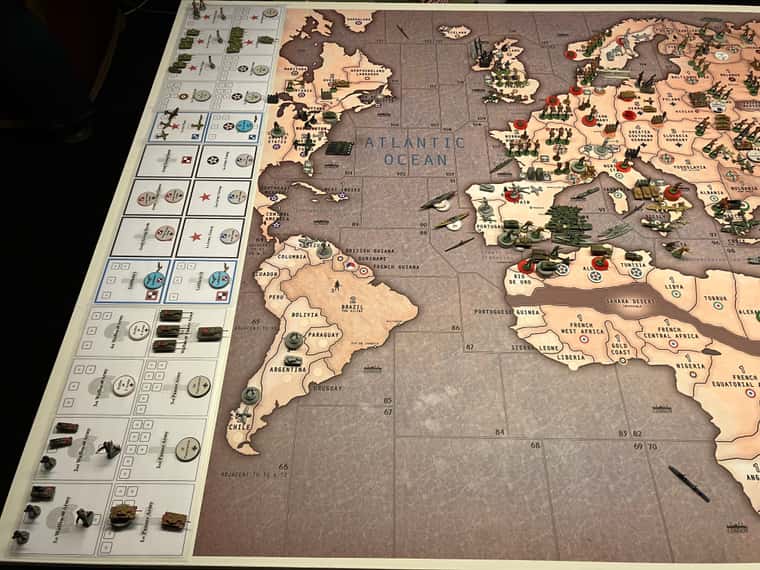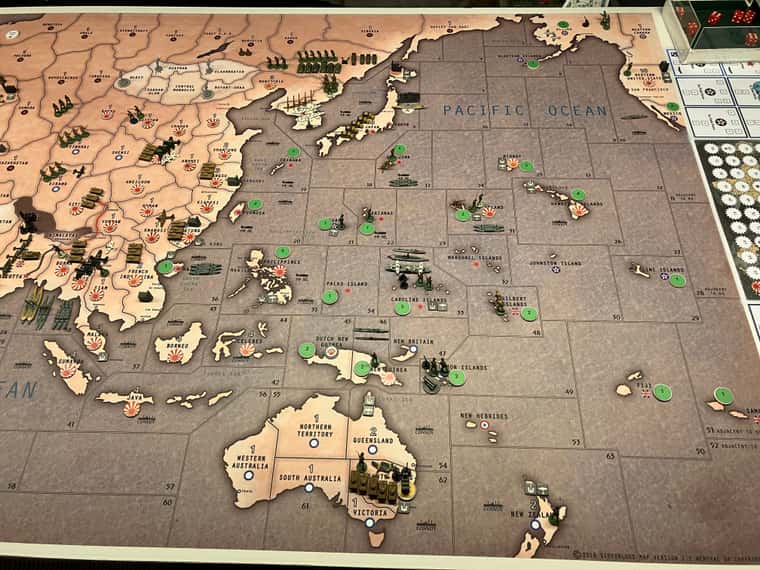Continuation of Multi Game 1 Report
Regarding True Neutral Units removed in Spain.
Well Victory removed it here https://forums.triplea-game.org/topic/4020/exp-crockett-victory-panzer-beelee/338?page=17

I’m not sure why he did. I didn’t catch it at the time. Do you remember why those were removed @VictoryFirst ? Long time ago I know :)
Well, it wouldn’t have affected the outcome. Maybe another hit or two for Spain is all.
https://www.axisandallies.org/forums/topic/37723/global-1940-1943-expansions-game-reports/730?page=30
Well I just got burned on America’s 30 min turn report, so take a bit to get back into it :)
Uncle Sam would go with a heavy Army buy, as well as a AB for Espana.
Strat Bmbrs would do 17 Damage to the N Italy Fctry. No Interceptors would rise to challenge the 5 Ftr Escorts and the AA Guns would all miss their targets.
Small battles would take place across W EUR and the Pacific. US Naval Forces would be concentrated in 110. Large numbers of Army Air Corps would be based in Spain.
The Java TF would move to 39 off India, with major Air assets landing in India.
The Hawaiian JPN DD would be sunk but the Islands remain under JPN control. TF 7 splits, with the majority going to 3 SZ off Kamchatka, the others to the Canadian West Coast.
There are 9 Trprts in 101 off the East Coast.
China continues to struggle for Freedom. Their resolve remains strong.
Well the above isn’t as good as what I wrote earlier but whatever lol
UK buys 2 Trprts and some Army. They save 20 bucks.
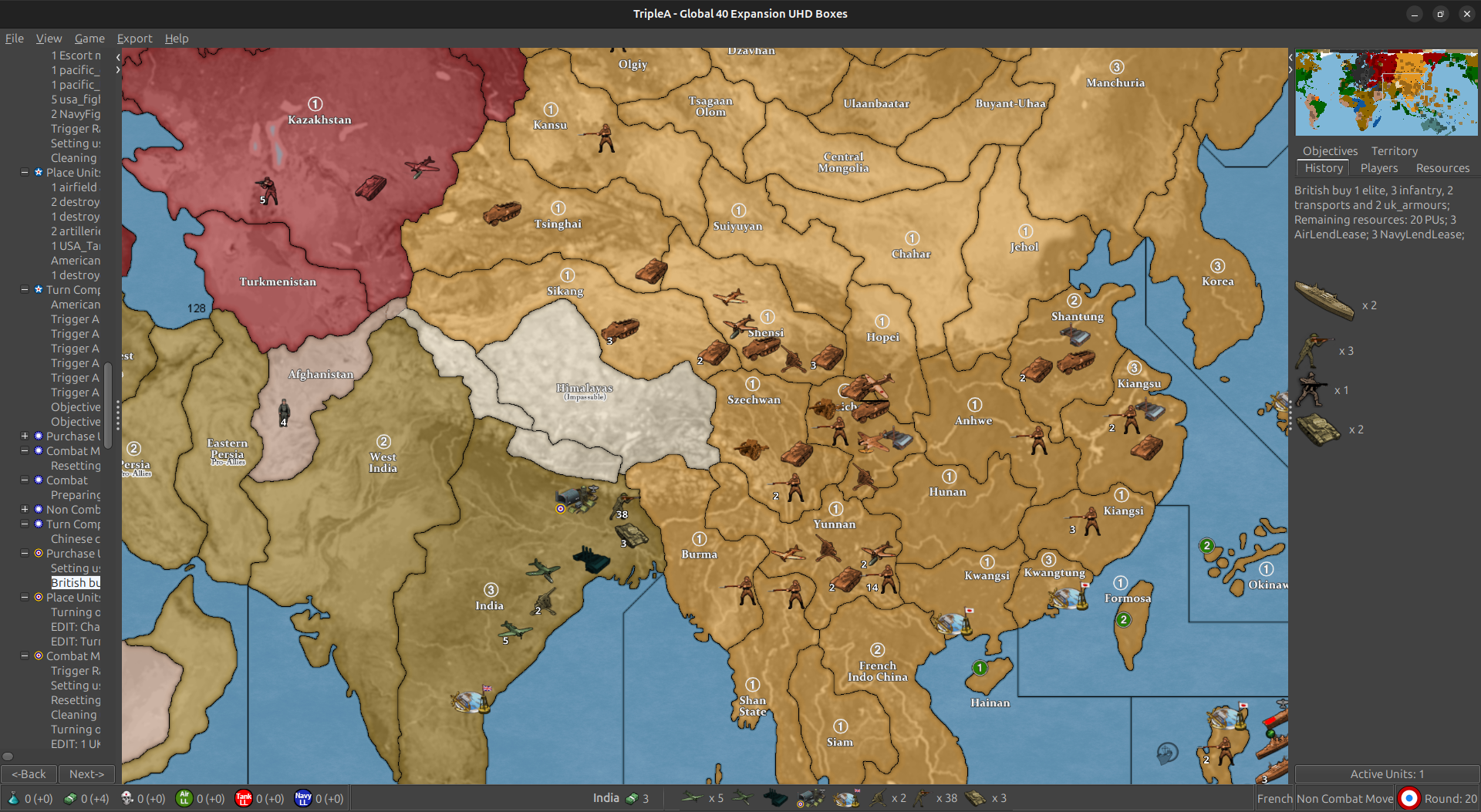
Then 20 is deleted. I’m not sure why.

I will have to check the game thread as this makes no sense to me.
OK. It was for the India Fctry. I didn’t realize Victory was still with us at this point :)

Major combat takes place in Greece


The Reich would prevail in a close fought battle. HOL and Iraq battles would see the British victorious. The Indian Army would once again move into Burma in Force.
UK would reinforce the Russians in Turkey and produce Tanks out of their Egypt Fctry.
Italians are looking forward to their arrival in US prison camps.
ANZC would produce Ships for their Navy and give battle to the JPN Escort and Trprt off Celebes with a SS and Air attack. The attack would succeed but with heavy losses. A lone Ftr would be left after the intense combat.
Their Aircraft Carriers would join the Americans in 39, with another supporting US Ships off Johnston Island.
Continued 10-22-25
Late 1945
The Reich purchases another Panzer Army, as well as moving the W GER Fctry underground and upgrading it. Infantry, Paras and a Hvy Bmbr also deploy.
The Type XXI would begin a new phase of the U-boat war by getting a hit on a Hvy BB in 110. W EUR would see massive counterattacks supported heavily by the Luftwaffe.
Novgorod would be taken in force with 1st Panzer and 1st SS. A UK Trprt is sunk off Greece.
1st SS Pnzr would move to W GER and 2nd Pnzr and 2nd and 3rd SS to Romania.
The Scandanavian Army moves to Norway.
The Soviets would invest in Total War Tanks and small combats would take place on their European Front. Central Asia and Western China would also see combat, with Sikang seeing a moderate clash of Forces.
The Moscow Army moves to Bryansk.
Japanese Demolition charges are placed at the Bases in Hawaii. Support Ships are launched for the Navy, with the rest of their resources going to the Army.
Major battle takes place in Sikang.
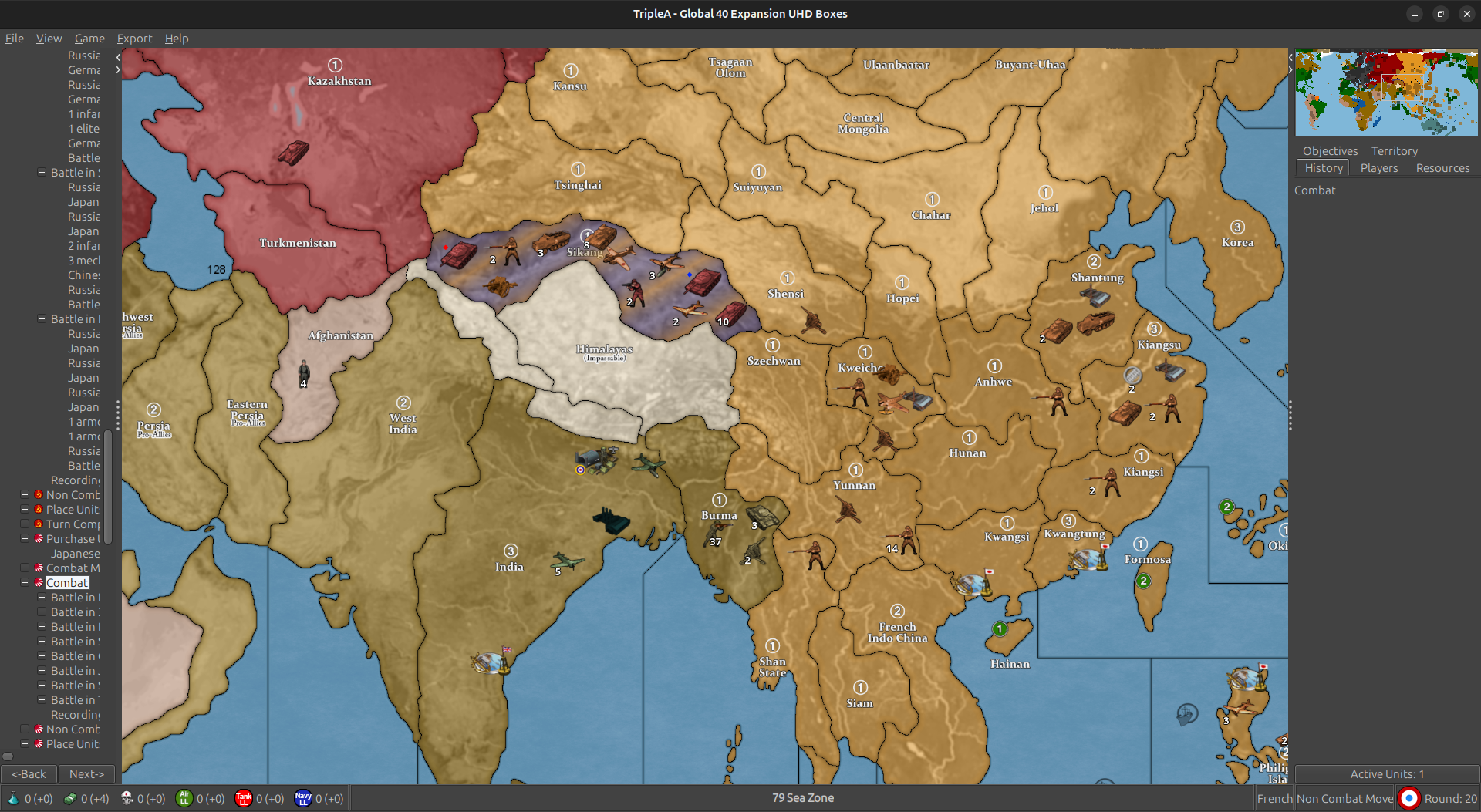
Nippon would win a costly fight.
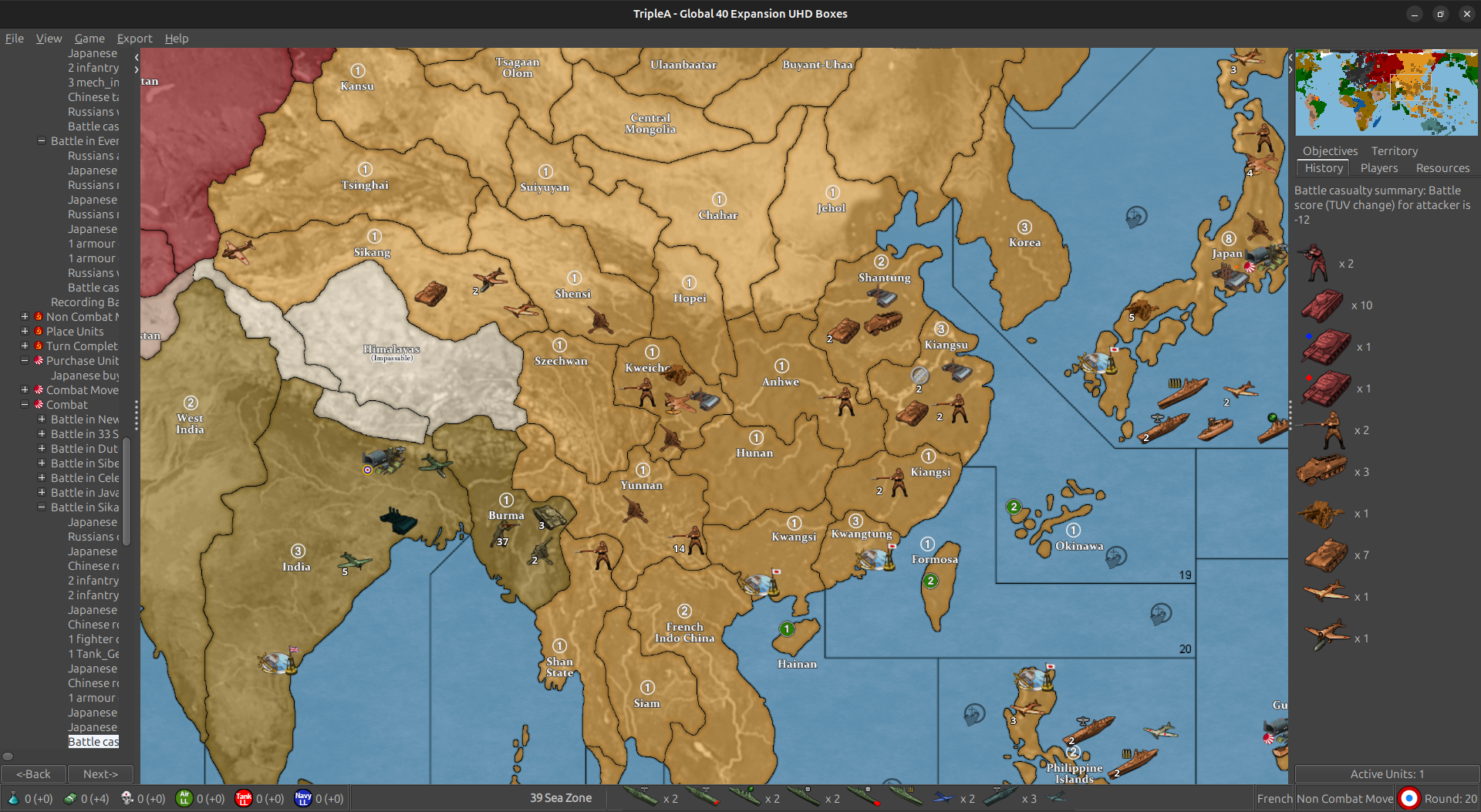
Closely matched Forces would faceoff in Timguska and Siberia. Java, Celebes and DNG would also see combat. Japan would prevail in all battles.
IJN would be dispersed off the above SW Pacific Islands, while the PHI’s would see the greatest concentration of Naval assets.
The IJA would be concentrated in Kweichow preparing for potential battle against the British Indian Army in Burma.
Uncle Sam would go with a heavy Naval buy that would include 2 CVs and 2 CAs, along with 4 Total War Ftrs. I don’t normally see Cruisers built in our small play group, but they do have value at 9 bucks in The Capatain’s mod. Especially if you plan on large Amphibous attacks that can’t be blocked by bombard. They still hit at a 3 regardless :)
W EUR TTys would change hands again. US Naval Ftrs would canopen for the British in Shan State, albeit at the loss off a Ftr. They’re only 6 bucks though and Crockett learned early the risk reward of using them in battle.
Siberia would see the largest battle and USA would win easily. Portugal would fall to an Amphibous landing with heavy Armor support.
There are a large number of USN Ships scattered throughout the North Pacific. The TF off India moves to Singapore and is directly challenging IJN units in the PHIs.
New Ships continue to flood into the Pacific. The Atlantic Fleet remains in 110.
China hopes their new best friends the British can liberate some territory, as the Soviets are having trouble defending their own :)
UK buys Tanks and Mech Inf. There would be a correction on the Mechs, as Crockett didn’t realize he couldn’t do Total War builds in India.
Still, the 5 Mech would be a good purchase.
A small battle would succeed in Greece and the Indian Army would move into Yunnan in strength.
I may have missed something with a edit in Iraq as the 2 Tanks didn’t move, no reason or well not a good one that I can see :) they didn’t move. It may have been changed in the future or just been missed.
It happens in a complex game like this :) or it’s part of crockett’s master plan :)
At any rate, British Tanks have taken control of SE Asia. AA Guns are sent to Yunnan to support the 36 Infantry Divisions there.
Hmm … not a whole lot going on in Europe. 6 Tanks in Caucasus and Cairo produces 3 more are the biggest moves.
ANZC produces 3 Tanks. Combat takes place in 46 with a SS sinking a lone Trprt.
The French are confined to base as English resentment continues to grow.
End Late 1945


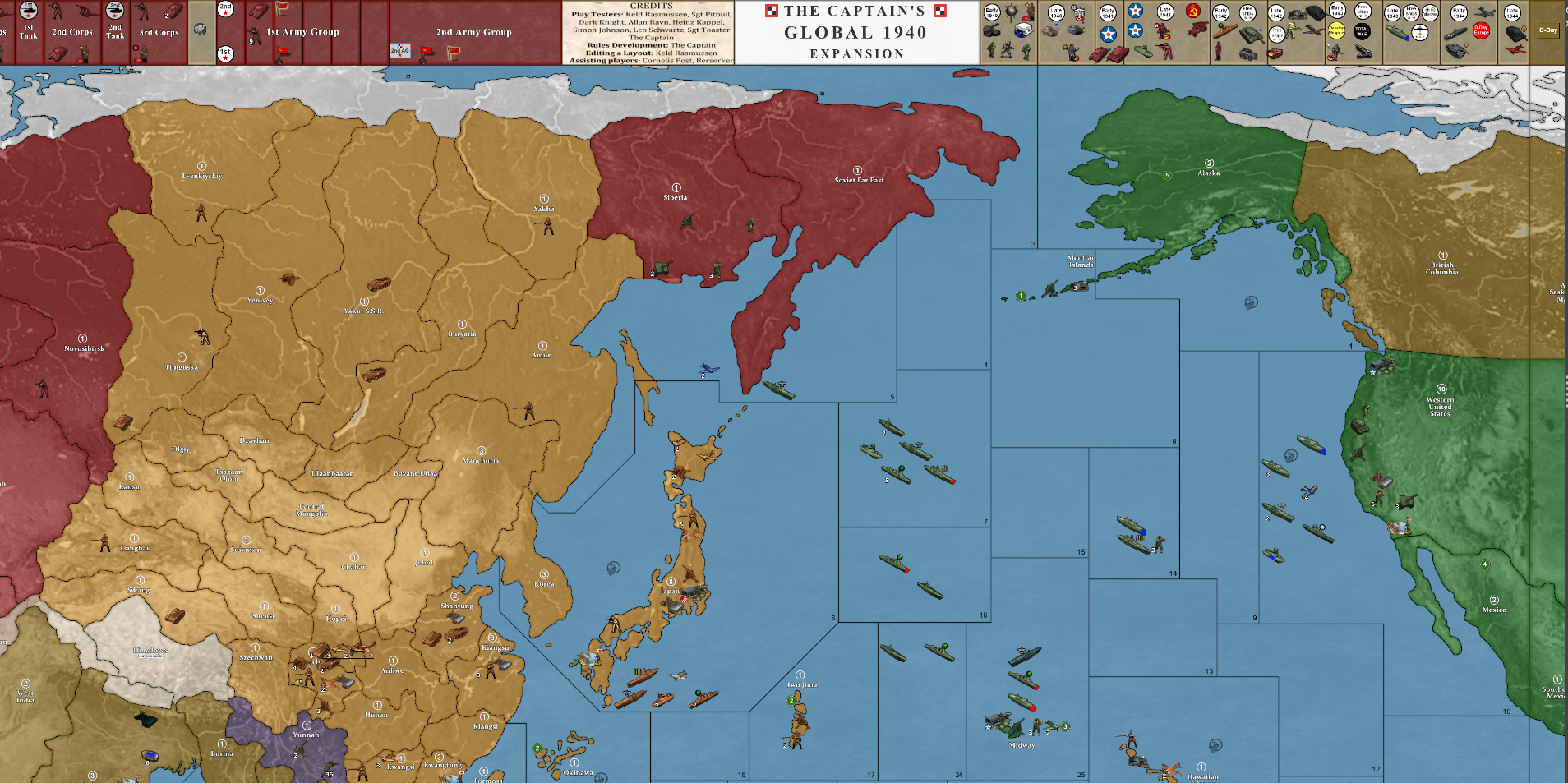
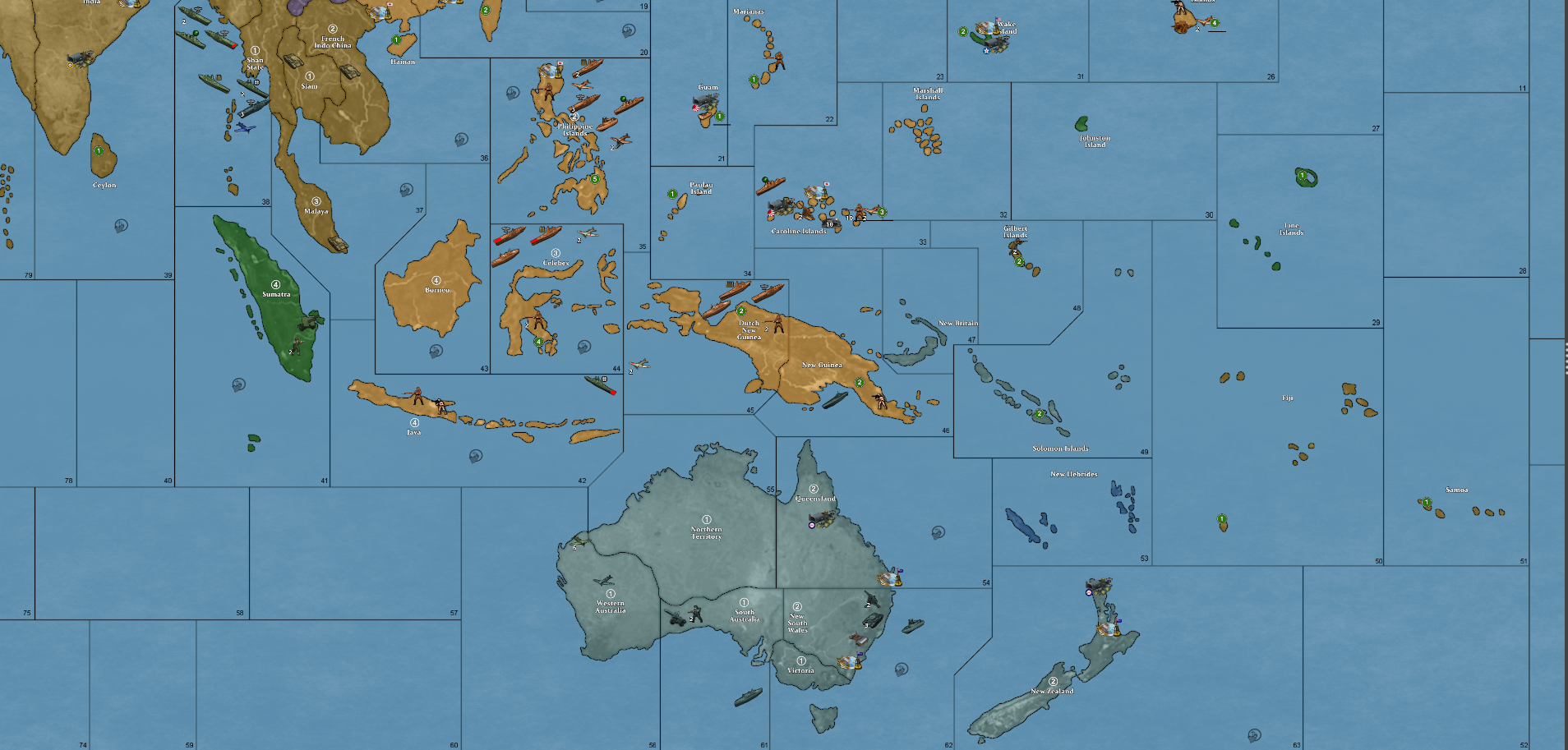
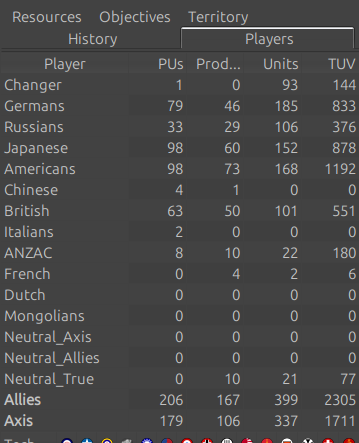
Edit
The USN moved to 38 from 37. I can’t remember why but it should be documented in the Game Thread. I’ll look before next post :)
Edit
oh yea just a simple mistake :)

Continued 10-25-25
Early 1946
The Reich would go with two Total War Mech buys, along with large Infantry and Para builds.
Tigers would be repaired and another Type XXI U-boat would launch.
A Hvy Bmbr, immune to AA Fire, would stike Moscow and cause 10 damage.
N Italy, Greece and S FRA would be taken via counterattack. Normandy and Bessarabia would also go down in defeat.
A rule misunderstanding on my part would see S Italy taken by Paratroopers.
Paratroopers are forbidden from attacking Capitals. Even if it’s not under control by it’s original owner.
This would be corrected at end of Soviet turn.
The Moscow Fctry would be repaired and moved underground. 3 British Tanks would be activated via LL and 3 Partisans would prepare to become active in original Russian and now vacated Axis controlled TTys.
Combat would succeed in W China and Central Asia. Partisans would cut Ground Lines Of Communication, GLOC, in Baltic STs and E POL, preventing German Rail movement to Belarus.
The “Karelian Knot” anchored by 1st Army Group, would remain intact, as well as the Moscow Forces.

Japan would go with a mixed build fortifying their Navy as well as the Army in China and the Home Island.
They would conduct numerous small strikes in the SW Pacific, most notable being Singapore. Isolated USN units would also be struck in 16.
The main event would take place in Yunnan.
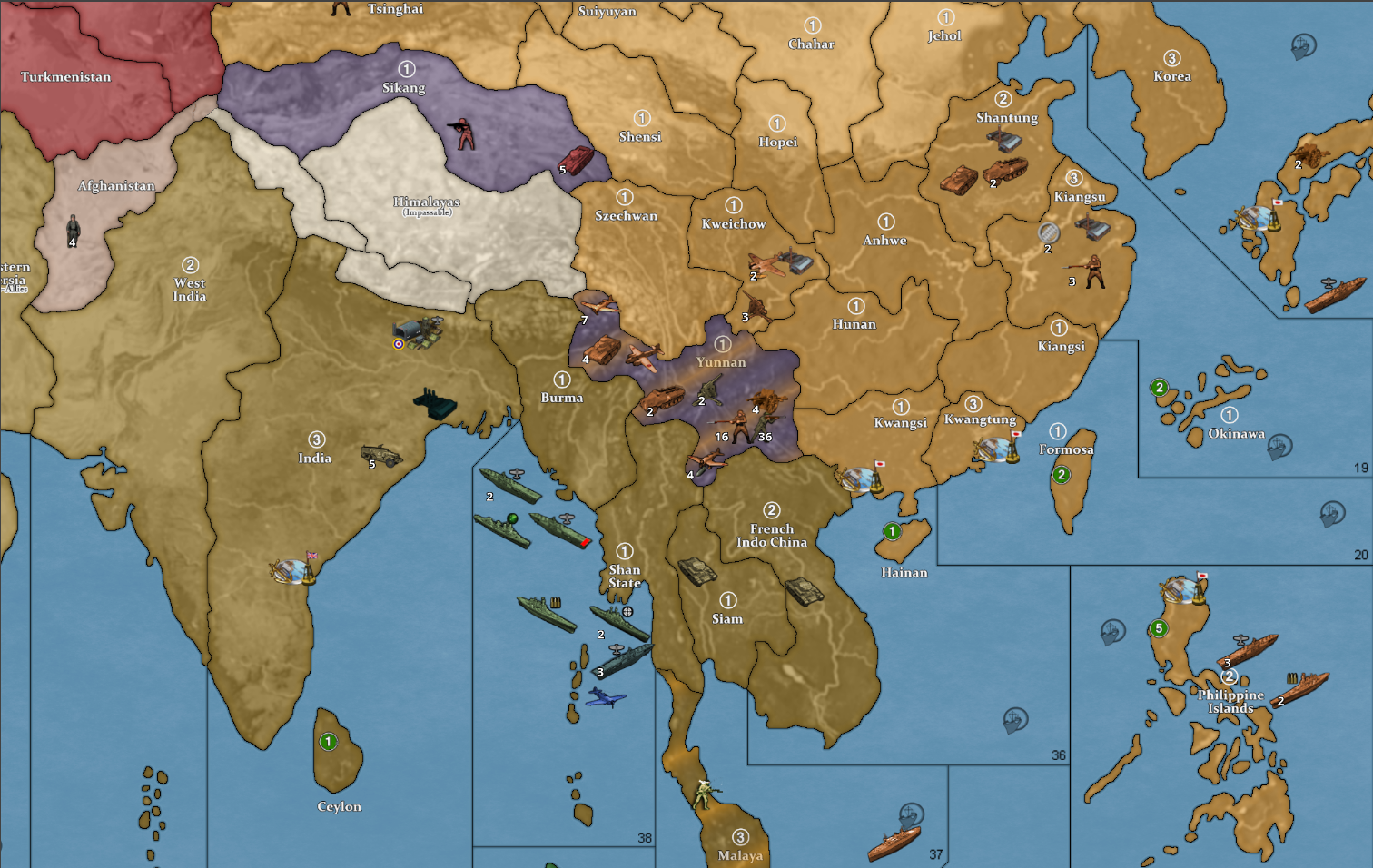
JPN would have good odds
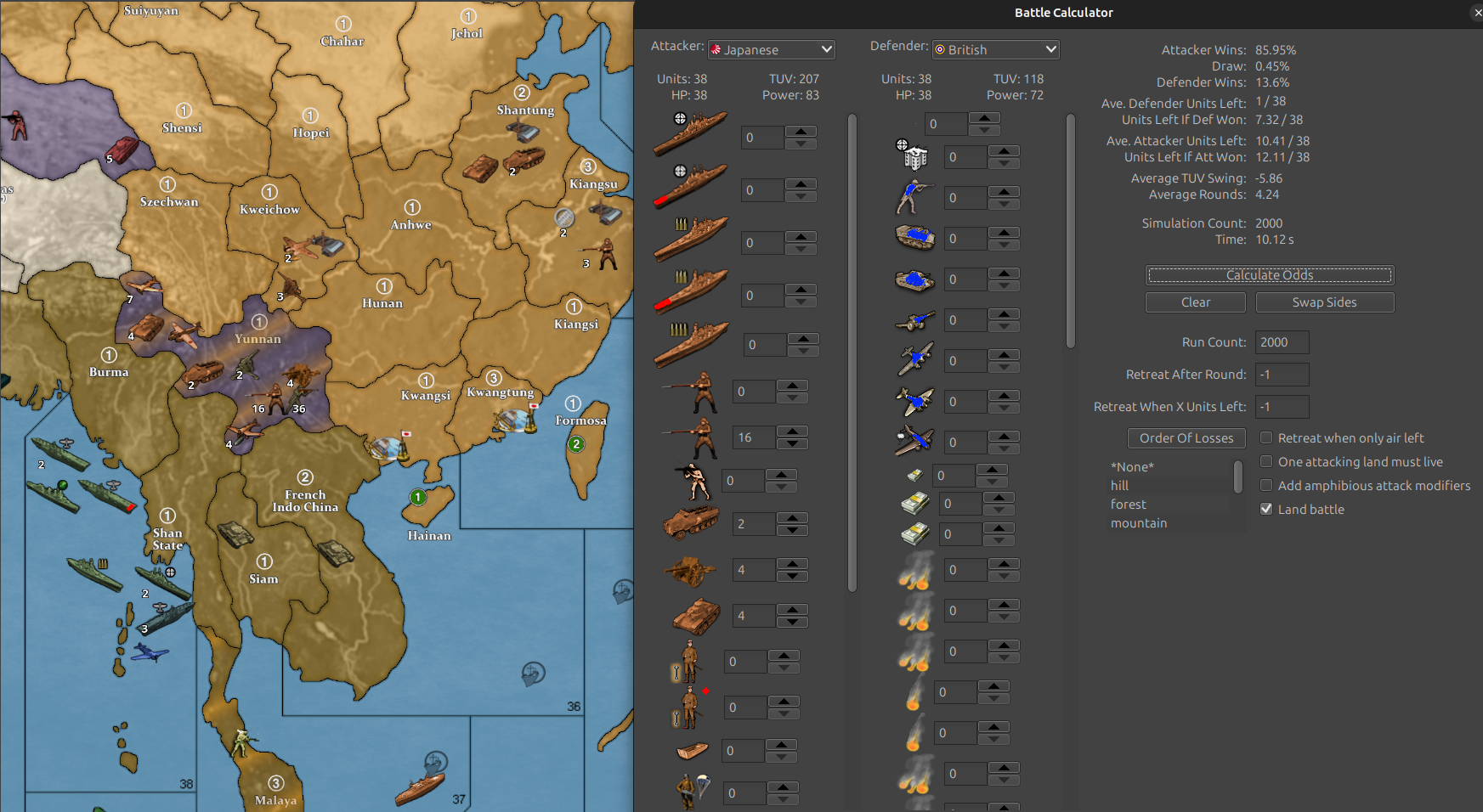
All UK AA fire would miss. JPN would hit slightly above avg by 2-3 hits first rd of battle. Unfortunately for the British, they would hit 3 hits below avg.
JPN would hit slightly below avg rd 2 and the Brits would once again underperform.
This would result in a Major Japanese Victory.

The IJN would be concentrated off the PHIs and in 6 SZ. The Army in Kweichow, with strong mobile Forces, as well as Air Units, to go along with the surviving mobile units in Yunnan.
Continued 10-28-25
USA would go with Total Naval Ftrs and heavy Armored Inf and Marine builds. A slight correction would be needed to a rules misunderstanding.
Numerous combat would take place in both the Pacific and European Theatres.
Northern Italy would be taken with large Bmbr support and Normandy would see a dominating win.
112 a German Escort would be sunk and US Infantry would take Norway.
Japanese Ships would be sunk in 37 as well as the DD off HI, although it would take a Escort with it. Wake and Hawaii would both be liberated.
A daring all Ftr attack against the two defenders in Java would result in the destruction of the JPN, albeit at the cost of 2 Ftrs.
Sakha and Amur are liberated. Sakha would have a moderate Force of Infantry and Artillery. The main US Fleet would be in 7 SZ and the SW Fleet off Java in 42.
The Atlantic Fleet is primarily in 112. Troops continue to be produced in Spain and deployed via E Coast Trprts.
UK
Britain would focus on Bmbrs and Tanks. Battle in Yunnan would see the Japanese victorious but they would be heavily attrited opening the way for a potential Soviet attack from Sikang.
S FRA would also see heavy casualties, with UK destorying the German presence there but only a lone RAF Ftr would survive.
British Armor would move to Bryansk to block Belarus from Moscow. The Soviet Inf would be edited to Moscow that was there. Not sure why that was. Would have to check Game Thread.
Yea so Allies forgot a blocker and then realized they could get a UK Tank there instead is what I think happened. so all good.

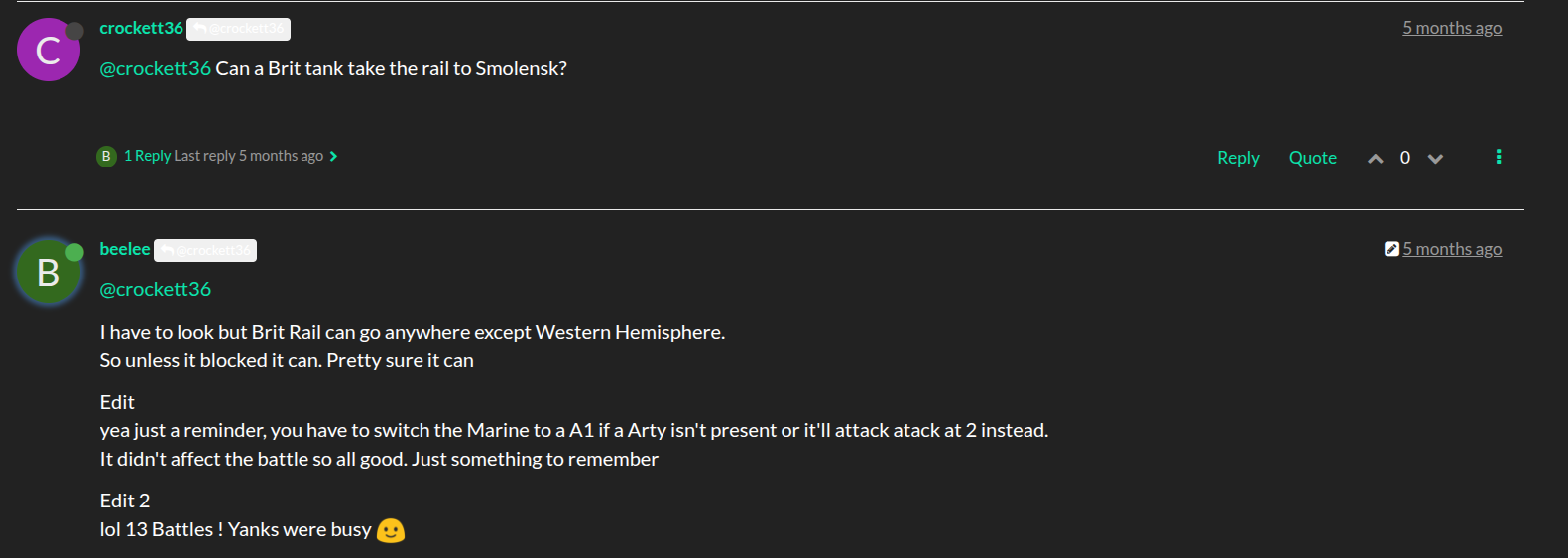
4 Tanks would deploy to India and 3 Bmbrs to Egypt.
ANZC
They would take a now undefended Java, helping to boost their IPC level, which had fallen quite low.
Late 1946
Germany produces a double build of Total Mechs again, along with a Tiger. Infantry and Paras for future SS induction will also deploy. The Kriegsmarine will launch another Type XXI, bringing their total to 3.
Combat all throughout the Eastern and Western Fronts would take place. Norway and Normandy seeing the heaviest fighting.
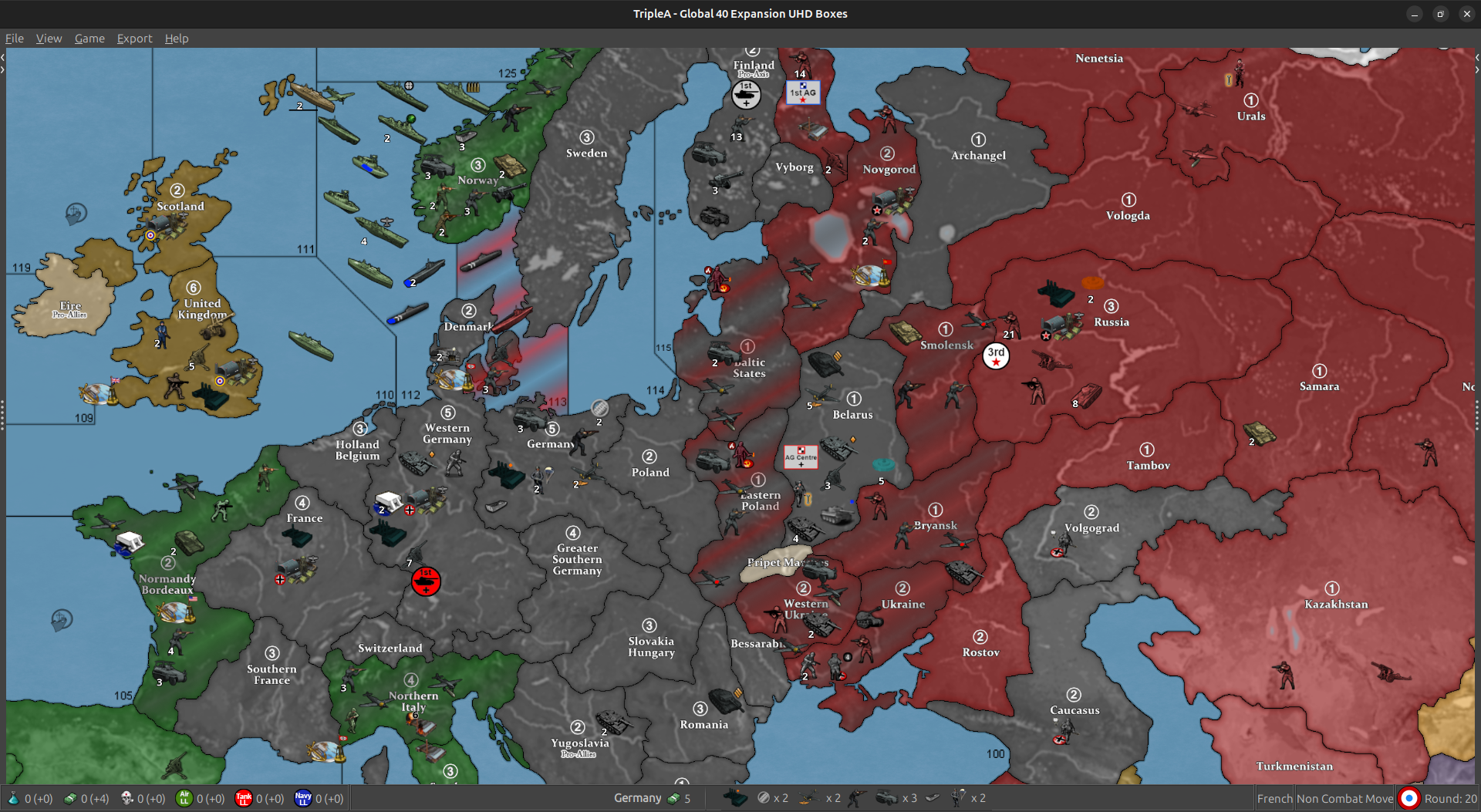
I just noticed Air was used against the Partisans. This is incorrect. Idk if it was corrected or not. My guess is it was missed. I might be able to adjust Partisans so Air can’t fire at them. I put it on the list to look at.
At any rate, all attacks would succeed.
Belarus, Finland and W GER would see the largest concentration of Wehrmacht and Waffen Units. Turkey and Rostov would be threatened by smaller but still poweful German Forces.
The Waffen Army in UKR would mistakenly have a Oberst 4 active instead of a 3. This is corrected in the future.
USSR
The Soviets would produce a Tank Army. A large number of Combats would take place in both Theatres.
Most notable would be 1st AG moving to Novgorod. A large number of Chinese TTys would be liberated and while still a victory, they would suffer the loss of a Tac in the retaking of Smolensk.
I think they went a little light and could have used some more Infantry support there. I understand wanting to keep Moscow as strong as possible but British Armor was also in position to block. That Tac would be missed for counterattacks in the future.
Moscow has 1st Tank and 3rd Corps both active and able to form 2nd AG when needed. 1st AG is threatened from Belarus as well as fast movers from Finland.
Luftwaffe Units from W GER can also strike.
Japan
Nippon would build 2 CVs and Total Naval Ftrs. They also upgrade their Air Base and round out their purchase with 2 Tanks and the rest Infantry.
They would counterattack in China but be unable to regain control of all of it.
Naval Units from the PHI would move to Home Waters and the Army would be concentrated around their Fctry in Kweichow. Some solo units would move into Soviet Asia to attempt to slow down the American and Communist Forces there.


Continued 10-29-25
USA would go with Total War Mechs and Naval Ftrs. 2 CVs and some support Ships. 4 Armored Inf would be the big purchase for the Army.
N Italy and Normandy would see battle once again, with the Americans taking both and absolutely obliterating the German Forces in Normandy with massive Air supporting the Army.
A few more battles on the Pacific side. All would be of the smaller variety, with NG, Amur and Buryatia being liberated.
The Atlantic Fleet would move to 109. The SW Pacific Fleet to 39 off Malaya.
China is finally not under complete Japanes control and is able to place 1 Inf.
UK goes primarily Army with a couple Trprts for it’s build. A small Tank Battle in Greece would see them come out on top and more Tanks would take Yunnan.
A solo Tank would also defeat a lone Inf in FIC. Tanks and Bmbrs would be victorious in Sikang. Tanks would kill the SS Para in Caucasus as well.
ANZAC launches a Trprt and a SS. An undefended Borneo is liberated. A Ftr would sink a lone Trprt in 36 but be shotdown.
End Late 1946
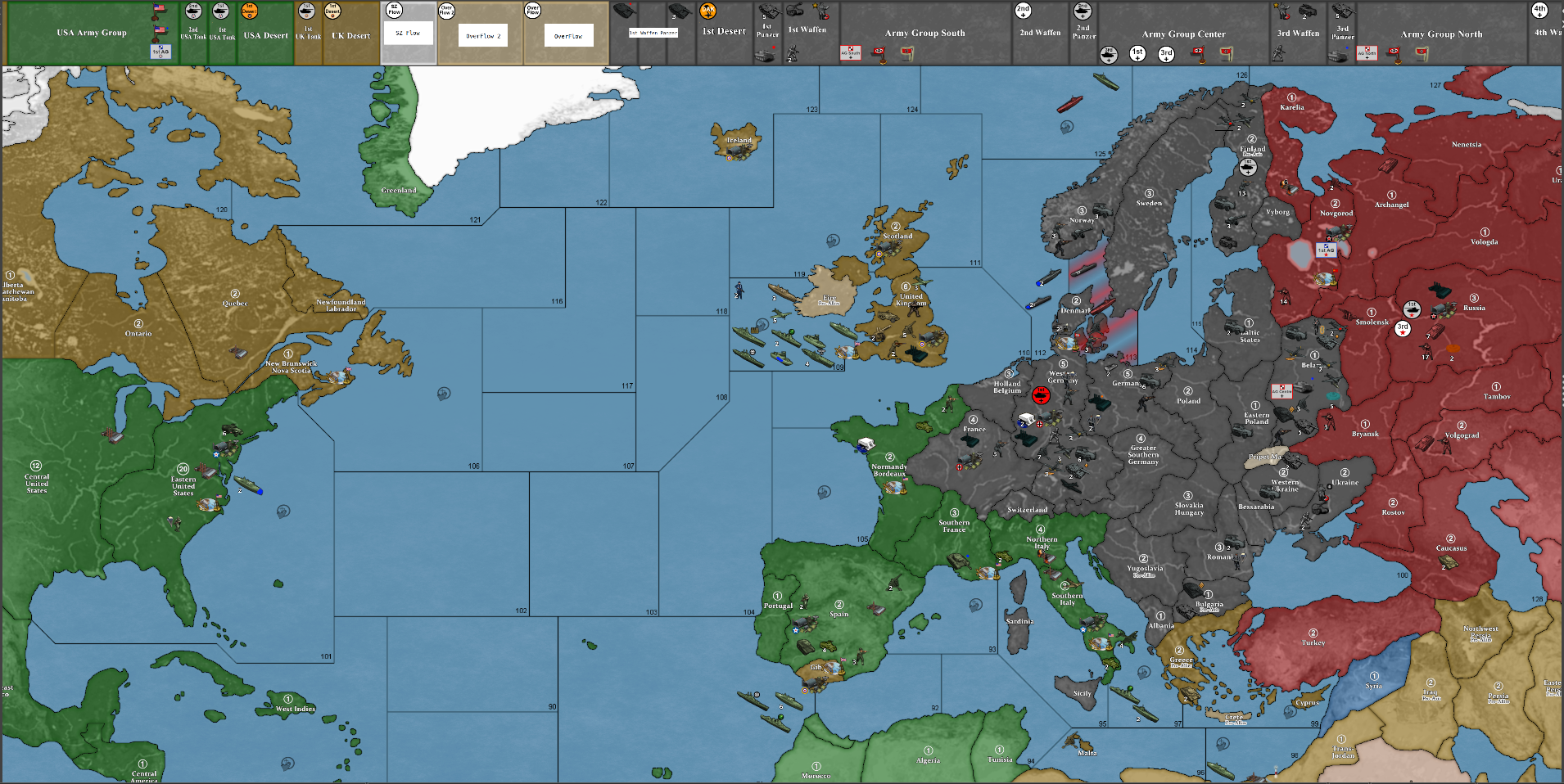
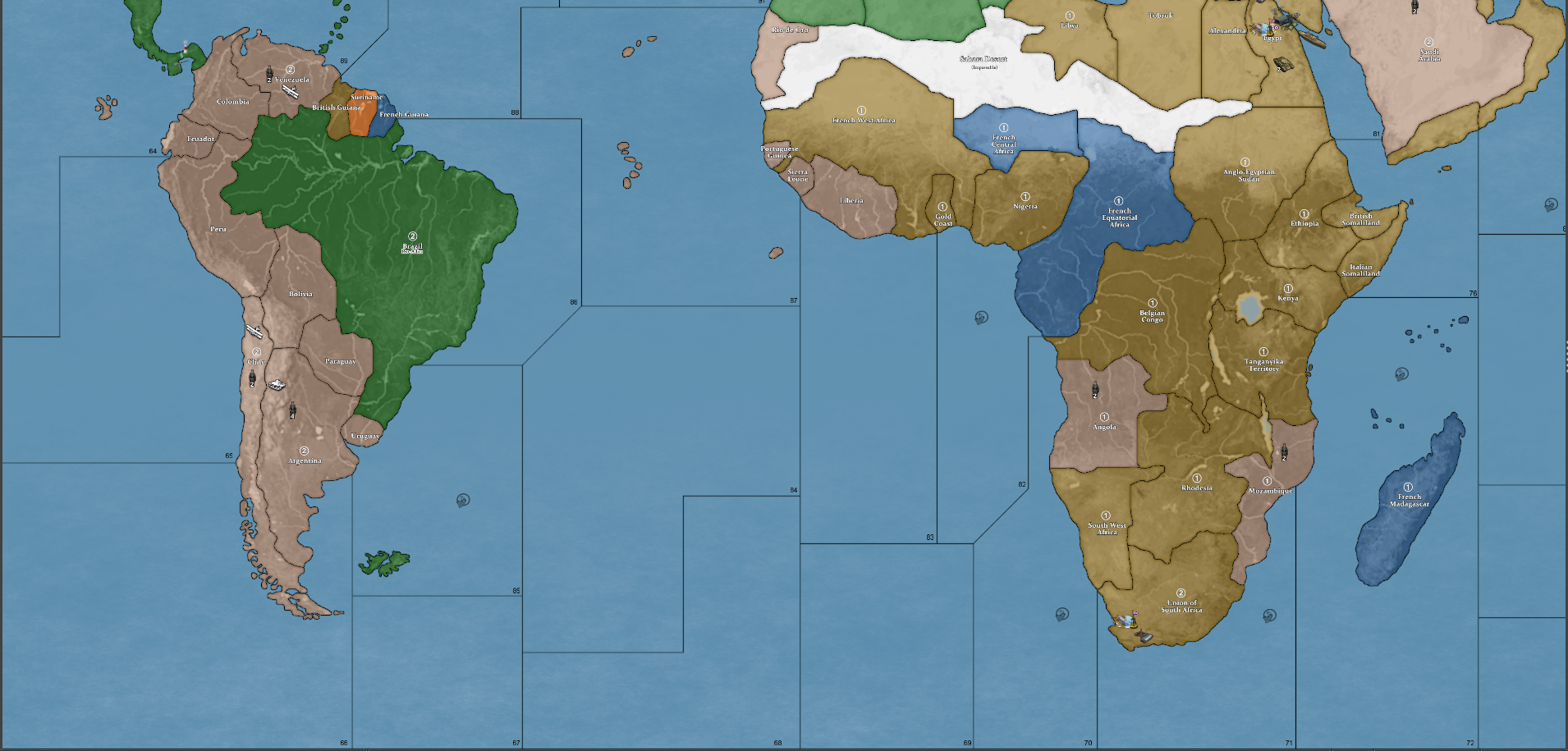

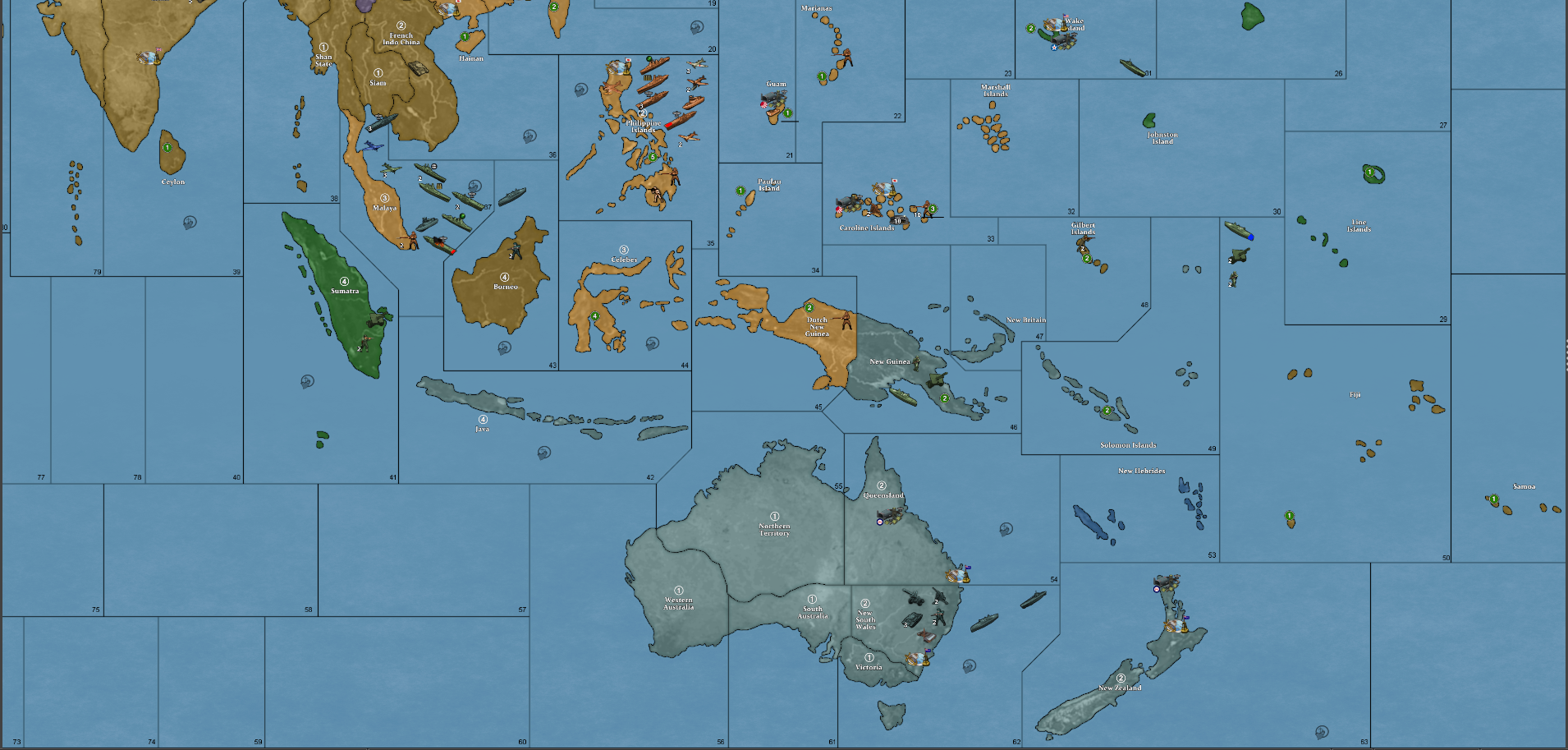
Economy
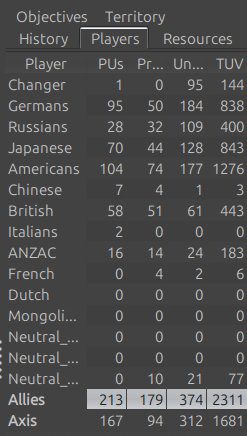
The Allies would have -7 for the Islands as well as -1 for a Partisan error in Yakutsk. Final Total
Allies 171
Axis 102
Continued 11-1-25
Early 1947
The Reich would go with all land buys. Total Mechs and Panzers, along with PnzrGrndrs and Paras. V-2 Rockets would make their first appearance.
In a brilliant tactical move, the Luftwaffe would send a stealth Bmbr to bomb the Harbor in GIB. This would limit the 6 American Trprts in 91 to 2 movement.
Note
Triplea will fire at Hvy Bmbrs with AA from Facilities. Regular based AA will not. If the AA should hit, simply edit the correct damage ( hand roll if against a Major Fctry ) at beginning of NCM and add the Heavy Bmbr back in.
A strong Force would move into N Italy led by 1st SS Panzer and 2 Tigers.
The 2 UK Tanks in Greece would be destroyed by a Hvy Waffen Panzer and support units.
Mech Inf with Air support would kill the American TG in S FRA.
Smolensk and Bryansk would fall with Ftr Ace led attacks. Normandy would change hands again. An undefended Turkey would fall to a Fallschirmjäger.
The main event would take place in Novgorod, where Soviet 1st Army Group would finally clash with the Wehrmacht.
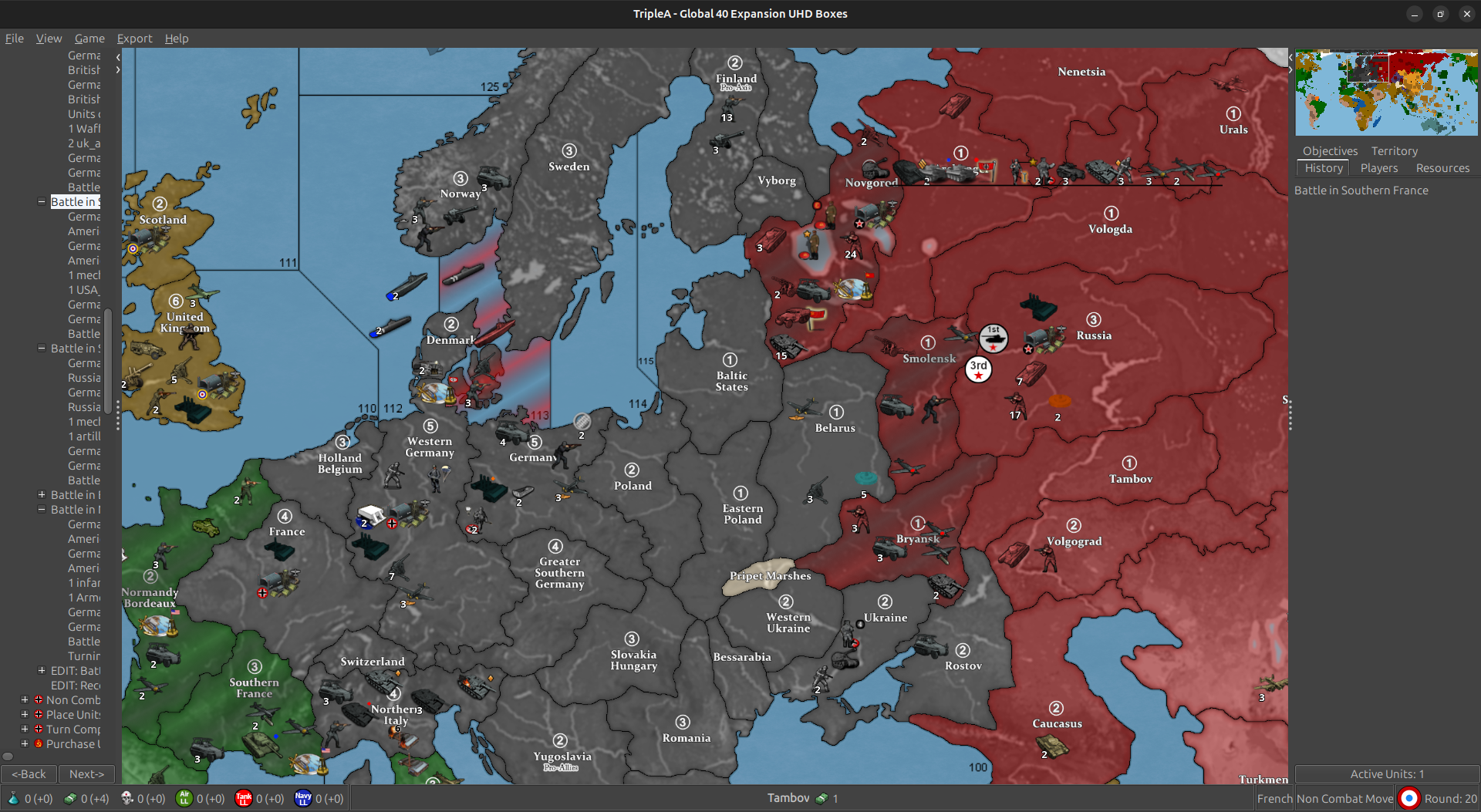
Odds would favor a German victory but with a negative TUV swing.
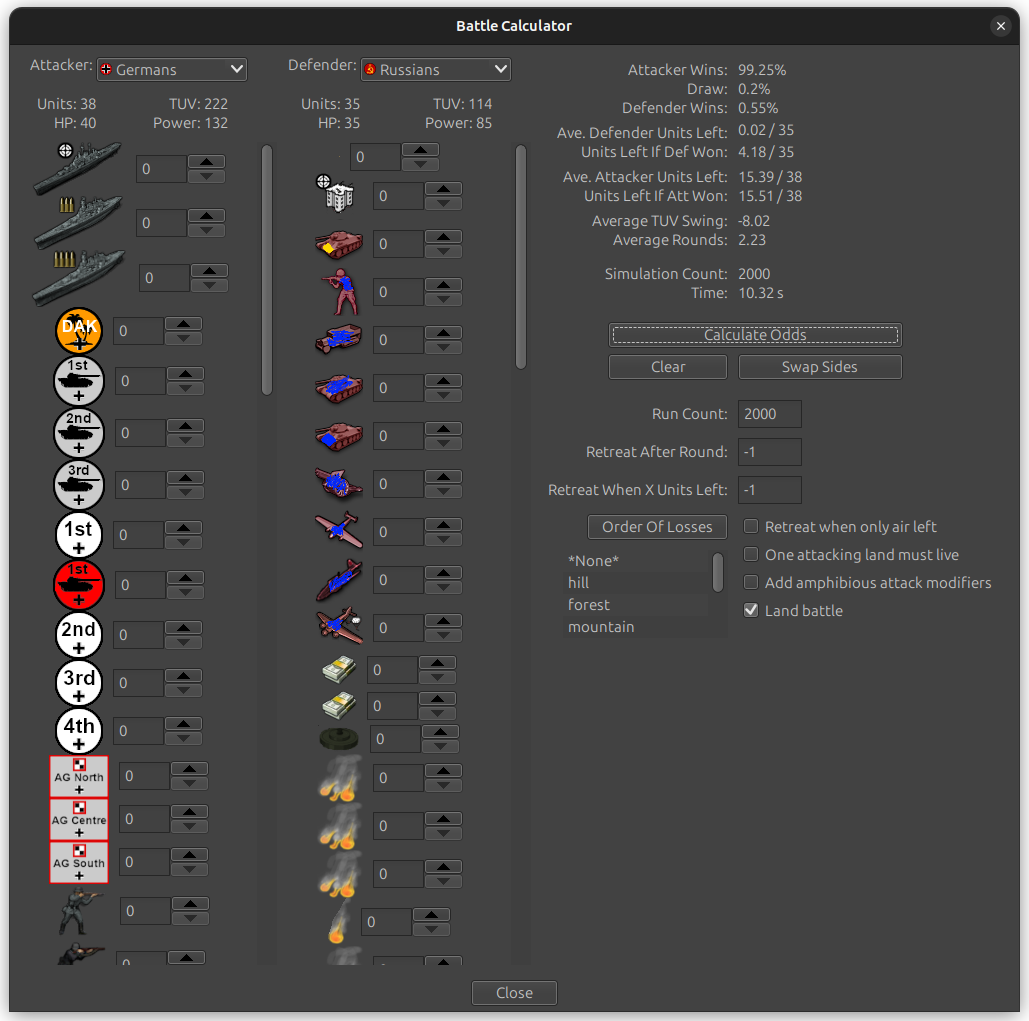
Note
Triplea Battle Calc won’t take potential AA hits or the non hitpoint of the AG Flags into account. One can manipulate it by removing or adding units to get a closer result sometimes.
The Reich would do slightly below average but still win the day.
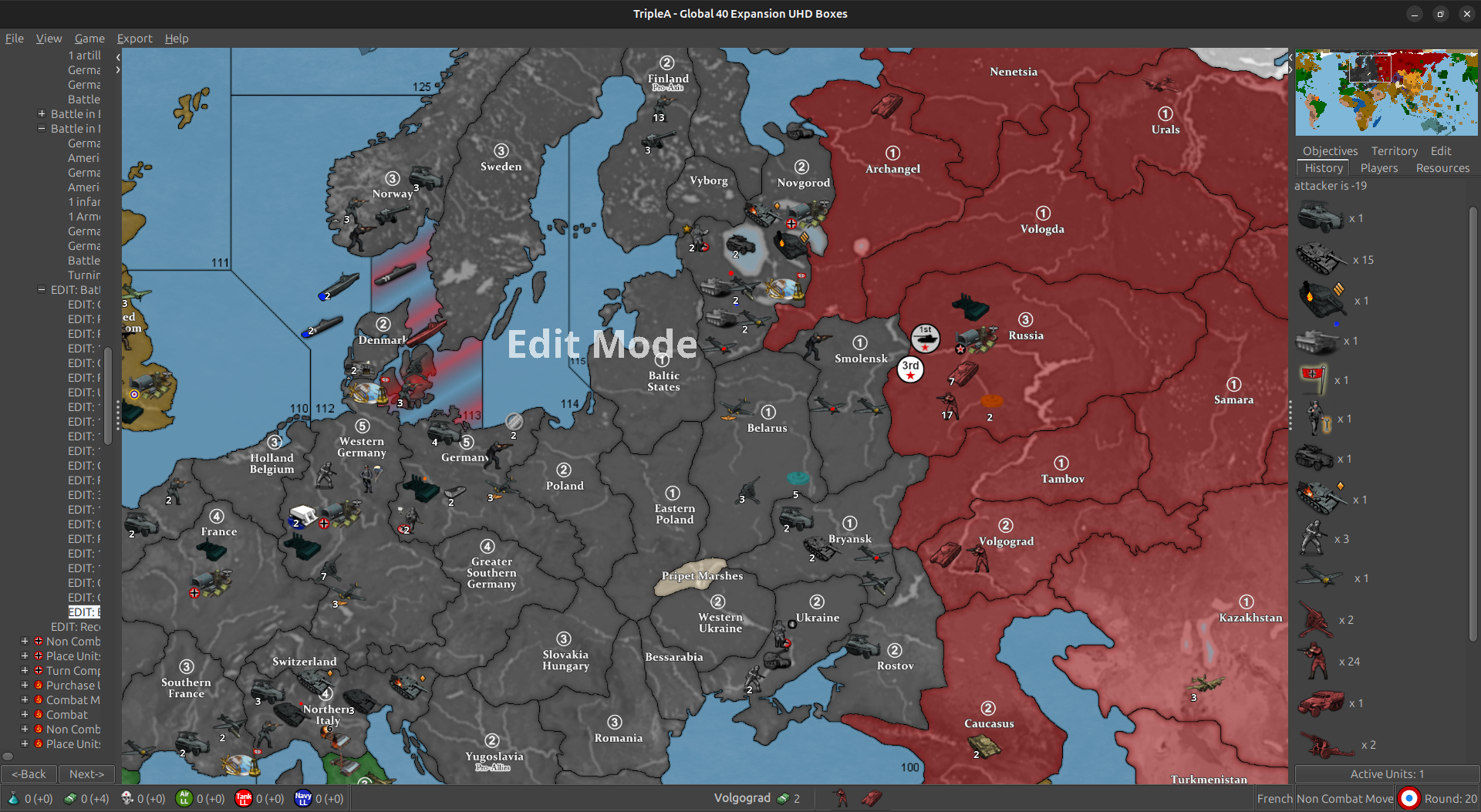
7 Air Trprts would reinforce Vyborg.
German End Turn
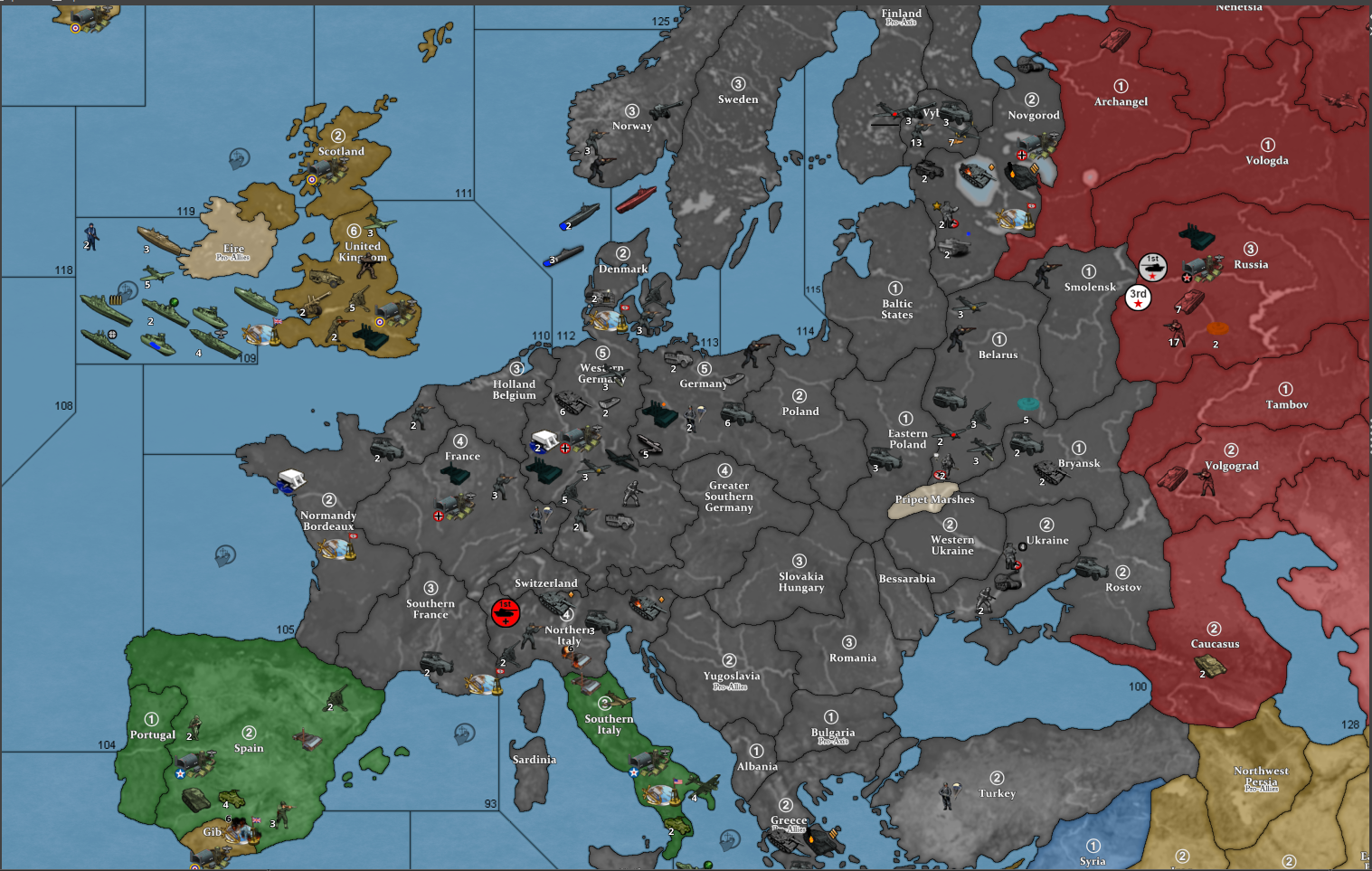
The Soviets would focus on Armor for their builds. The European Front would see multiple small combats take place, with Bryansk seeing a higher level of battle. Japan would also be attacked in Central China. All attacks would succeed, including taking control of Turkey.
1st Tank and 3rd Corps would be in Moscow with the ability to reform 1st Army Group. 2nd Tank would also have the ability to form in Rostov.
The Far East would be stabilized with the help of American Troops.
Concerned by the Allied Naval threat, Nippon would once again buy 2 CVs and Total Naval Ftrs. Infantry and a couple Fortifications would complete their build.
The loss of control of China and most of SE Asia, has them in a tough spot.

Japan would be forced into riskier battles than they preferred. Amur would be taken with massive Air support with no loss of Japanese Ftrs. Yunnan would see a moderate number of units clash and a Banzai attack would defeat the British Tank in FIC.
A Huge Naval Battle would take place off Singapore, with the SW Pacific Allied Fleet being engaged by the IJN out of the PHIs. They would be supported by land based Air from the main IJA base in Kweichow.

High odds of success, as well as a Huge TUV swing in JPNs favor, propel Yamamoto to order the attack.

The battle would end up with expected results

and be a Major victory for the IJN.
Japan would be feeling massive pressure from the Giant American Fleet in 7 SZ. The upgraded AB would be fully manned with 4 Ftrs and multiple CVs would help protect the Home Islands.
These victories would give Japan a slight reprieve from the Allied threat but the Americans have already launched a new Fleet from San Diego with Intelligence predicting even a larger number of Ships to follow.
Note
USA had incorrectly purchased more Naval Ftrs than allowed. This is corrected in the upcoming turn. Triplea is unable to enforce the correct number once Total War Takes place. Players will need to “Player Enforce” the correct number.
USA would go with Total War Inf, Bmbrs and Ftrs. A misunderstanding on placement would lead to them needing to make a slight adjustment to place correctly.
An undefended Holland and Celebes would both be taken. Normandy would continue to change hands. In Amur, the wrong Marine would attack but it would have no affect on the battle and would be liberated.
Marines
Marines have to be paired with Artillery on a 1:1 basis to get their bonus to attack. If they are attacking without Arty, you need to switch to “MarineA1” or they will attack at 2. They both defend correctly.
A 50/50 battle between a Arty and Inf in DNG would see JPN win. Iwo would see both sides ground units killed, so JPN would retain control of the TTy.
Note
When Bombarding with a Hvy BB and there is only one land unit in the amphibous attack, you will need to hand roll as the Hvy will roll 2 dice when they should only roll one.
American Air will strike France killing the German Infantry and Paratrooper but importantly, it would keep France under German control.
The Germans would be defeated in S FRA but would put up a good fight.
The Atlantic Fleet has moved back to 110 and Major Air assets are present in UK ( 4 Bmbrs 5 Ftrs ). Spain continues to be a forward area for deployment.
Iwo has the Main American Fleet and Wake, with it’s NB, adds support. Total War Bmbrs and Ftrs are deployed to the West Coast.
China produces 2 Infantry and with Vengeance on their mind, the lone Infantry attacks the JPN Inf in Kansu. Both Inf are killed.
UK would buy 2 Ftrs and match their Infantry build of 5 with 5 Artillery.
Bmbrs from Kazakhstan would make a daring raid on the damaged Ships in 37 off Singapore, sinking 2 BBs and a CV while 2 Bmbrs would be shot down.
Solo Tank vs Solo Inf attacks would both succeed in Suiyuyan and Hopei.
ANZAC would build a Air Trprt as well as a Harbor for Western Australia. The Powers that be would change their mind and cancel the Harbor build in favor of 2 Submarines.
An undefended Kwangtung would be taken by amphibous attack.
DNG would also see a sea attack defeat the JPN Inf there, although at the cost of an Inf themselves.
ANZC Subs and Trprts would be scattered throughout the SW and Central Pacific.
2 French Infantry end up in Spain. Idk how and I don’t care lol
End Early 1947




Economy

Highway to the Danger Zone ! Allies are getting close to an Economic Victory.
Allies
+2 Iwo Jima
+1 Celebes
+2 DNG
= + 5
Axis
+1 Guam
+3 PHI
= +4
= +1 Allies
End Early 1947
Allies 179
Axis 94
hmm … the numbers won’t line up. Well whatever that’s what it is.
Late 1947
The Reich goes with Panzer and Mech Total War buys. The damaged Tigers are repaired ( 1 PU a hit is a good deal ) More V-2s and some Infantry too.
Once again Western and Eastern Europe will see large amounts of blood spilt. Previous smaller battles begin to intensify, with Bryansk and S FRA as well as Normandy, seeing more units engaged.
Type XXI U-boats would strike the Allied Fleet in 110 knowing they can retreat to their Subpens in W GER.
Idk, but the Type XXI’s seem a bit too powerful. Idk what one can do about it. Maybe increase the cost ? Nobody buy them then lol
7 bucks one might though hmm …
It’d be nice to see some sort of Allied counter other than physically taking over the TTy they are based at.
My experience is only buying 1 maybe 2 a turn. The E Front requires so many resources. I guess it all depends on the game and the situation.
Well, anyway, back to the report :)
The Allied Commander in Gibralter would fail to secure their Air Defenses and once again suffer a Hvy Bmbr attack.

The German counterattack in Normandy would suffer Huge losses and not take the TTy despite killing all the Allied forces.
An undefended S Italy would be taken by Tiger Tanks.
Another close battle would take place in Turkey and the Reich would retreat back to Greece after inflicting heavy casualties. Whether this was planned is unknown but the Reich would gain a small TUV win.
I think pressing the attack here would have been the way to go. Allied Air and The Trprt in 93 and 99 would have most likely killed them in a counterattack though.
Still, it was two bucks and would make them react to you.
At any rate, they retreat to Greece with a positive TUV from the battle.
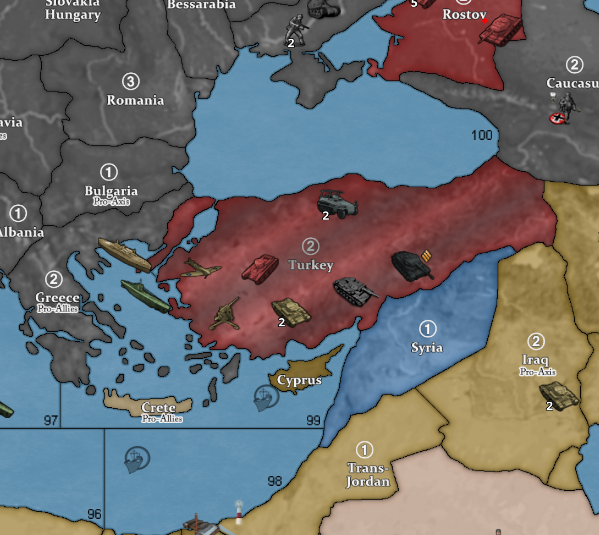
Bryansk is another tough battle. While not huge numbers of units involved, it’s more than just one or two.

but the Wehrmacht would secure a decisive win. Holland would easily be taken and S FRA would see another decisive victory.
1st SS Pnzr would be in France and W GER, Belarus, along with Greece would be heavily reinforced.
Continued on 11-3-25
The Soviets would go with a Infantry build including Grd units. Combat would take place in the Urals and Caucasus against the Waffen Paras. Both attacks would succeed.
2 undefended Chinese Provinces would be liberated.
Almost the enirety of the Red Army would now be concentrated in Moscow.
Japan buys a Hvy BB, CV, Naval Ftr and DD. Infantry and a Fortification for the PHIs.
10 Combats would take place. All would involve small Forces but would be of tactical importance.
The odds would be extremely close in a number of battles. JPN felt they had no choice but to engage, as the Allies would be able to continue their breakout in China otherwise.
Solo Trprts would be the Naval targets, while almost all available Allied land targets would be attacked. While they would suffer some losses, all attacks would succeed.
Air Trprts would reinforce Singapore, PHIs and Kweichow. The IJN would move to Home Waters to face the threat from the USN that is anchored off Iwo.

Japan is in a tough spot but their Navy remains strong and their counterattacks in China are able to hold the Allies off for now.
USA repairs Capital Ships and buys 10 Bmbrs. A Paratrooper from Spain takes N Italy and Albainia is conquered by amphib attack. Both were undefended.
Superior American Air power would help defeat S FRA and a all Bmbr attack in Archangel would succeed.
On the Pacific side, small Naval battles would take place and the Fleet would move to the Marshalls and occupy it.
Bmbrs would deploy to Spain and Eastern US. The Atlantic Fleet remains in 110.
While the desire for vengenance is strong, China refrains from attack and begins to rebuild their Army.
The British repair half of the damage to the GIB AB making it functional. Bmbrs and a mixed Army build complete their Purchase.
Risky attacks in Burma and S Italy would both see success. The Neutrals in Saudi Arabia would easily fall, although a British Tank would be lost in the process.
The Bmbrs would deploy to Egypt and the Army Units to India.
ANZC would invest in another CV and a Ftr. A solo Tank would defeat a single Elite Inf in Borneo.
End Late 1947




Economy

Allies control
Iwo Jima +2
DNG +2
Celebes +1
Total +5
Axis control
Guam +1
PHI +3
Total +4
Results in
+1 for Allies
-1 for Axis
Allies 175
Axis 100
Pretty sure that is correct. For every Pacific Island bonus that goes up the other side goes down an equal amount.
The only time it wouldn’t, would be is if the Dutch Islands ( DNG and Celebes ) are never conquered by both sides at any point in the War. Then it would just be a plus for the side that controls it.
@Trout this is what I couldn’t remember about why The Captain said sometimes they wouldn’t take DNG. I think lol
@The-Captain is the above correct for the Island calculation ? Triplea doesn’t count the bonus IPC, just the original.
Continued 11-7-25
Early 1948
Germany builds Total War Mechs and Panzers and a mix of land units. Another Type XXI joins the Fleet.
The Spain Fctry is bombed. V-2 Rockets are fired at S Italy. S FRA, N Italy and Albania would be attacked. Most of the combat on the E Front would take place in the North, with Turkey also being attacked.
The Rockets would miss their target and do no damage. The other attacks succeed but N Italy and Albania would take heavier than expected casualties.
The Type XXI’s would score 2 hits and withdraw to their SubPen.
The Wehrmacht is concentrated in Belarus and W GER. 2nd SS is in Rostov, supported by Inf and Artillery. A Waffen Hvy Panzer leads the way in Turkey.
The Soviets would activate 2 LL Ftrs from Britain. A TG and Grd Inf would also be produced along with an Elite and Arty.
Some confusion with how LendLease works would take place and be corrected in the Game thread. The discussion starts here https://forums.triplea-game.org/topic/4020/exp-crockett-victory-panzer-beelee/750?page=38
Small battles would take place in Smolensk, Bryansk and Tambov. The first two succeed successfully blocking the German Army in Belarus from Moscow.
Tambov would see a stubborn Mech do the Fuhrer proud dying for the Vaterland while destroying 2 Soviet Infantry and a Grd Inf which would leave the TTy in German control.
1st Tank and 3rd Corps would be in Stalingrad, with the majority of the Red Army in Moscow, led by 2nd Tank.
Japan goes with a heavy Infantry buy and a couple DDs. Also a LCV to continue attacks against Soviet Asia.
LCVs land in SFE and Siberia. A DD would land a Elite in an undefended Alaska. A risky battle in Tsinghai would see JPN prevail due to Air superiority.
Japanese Air would also sink an Austarilian Trprt off Borneo.
The entirety of the IJN is now in 6 SZ except for a lone Escort stationed in the PHI.
Singapore is reinforced via Air Trprt and Kweichow remains the main Japanese base in China.
Continued Below





















